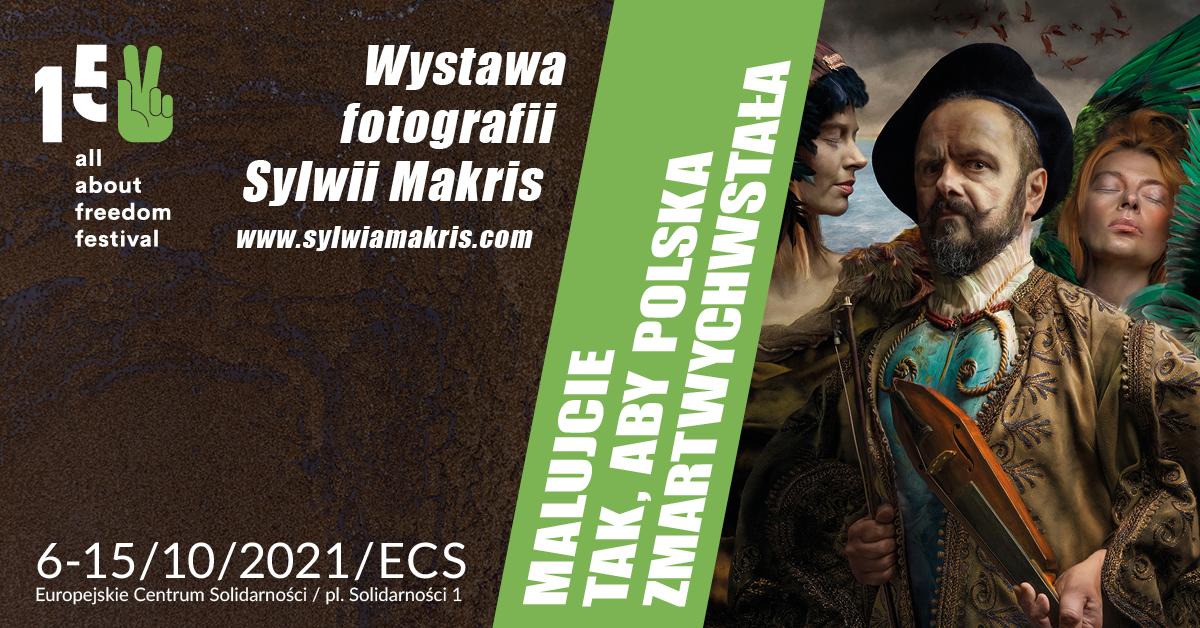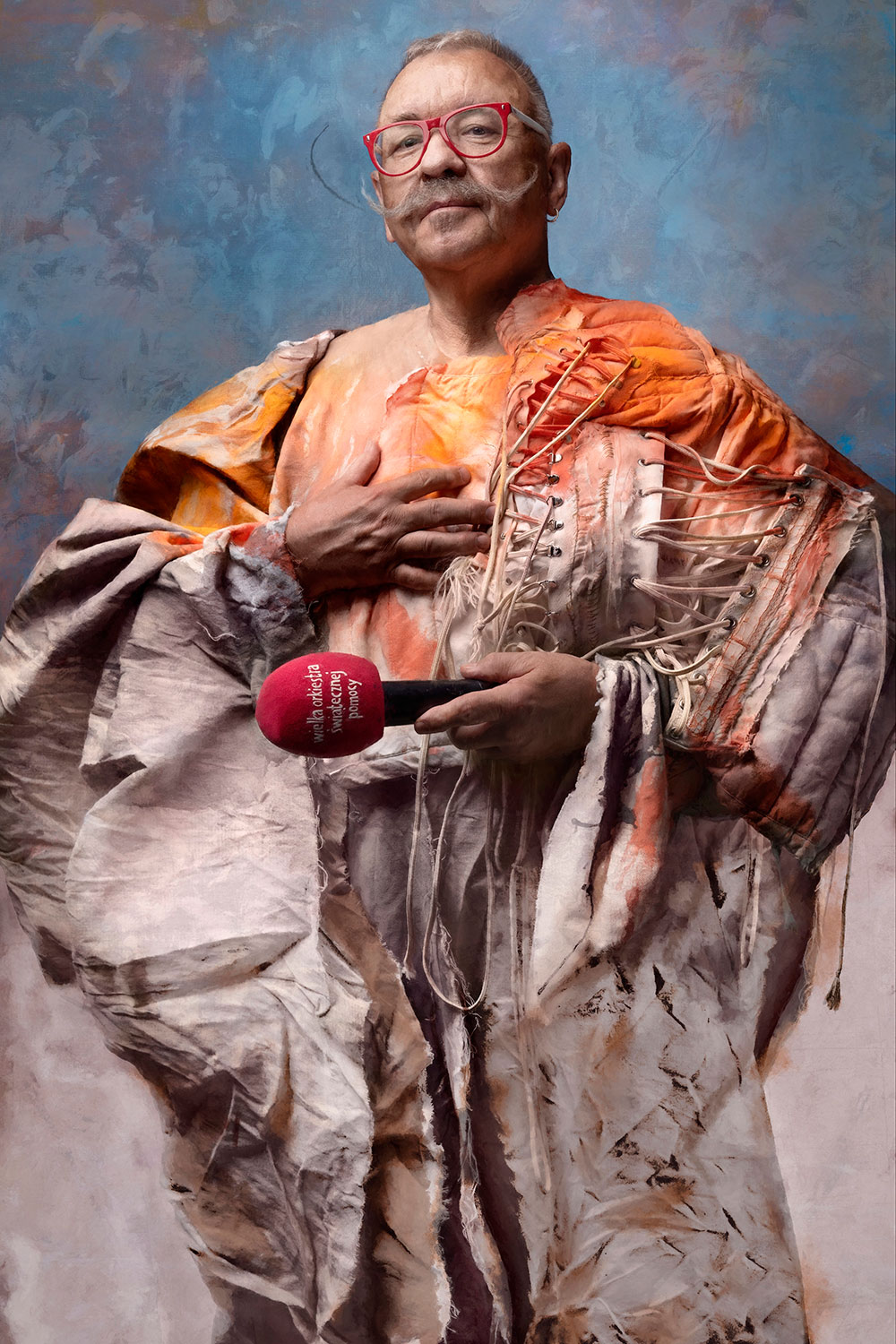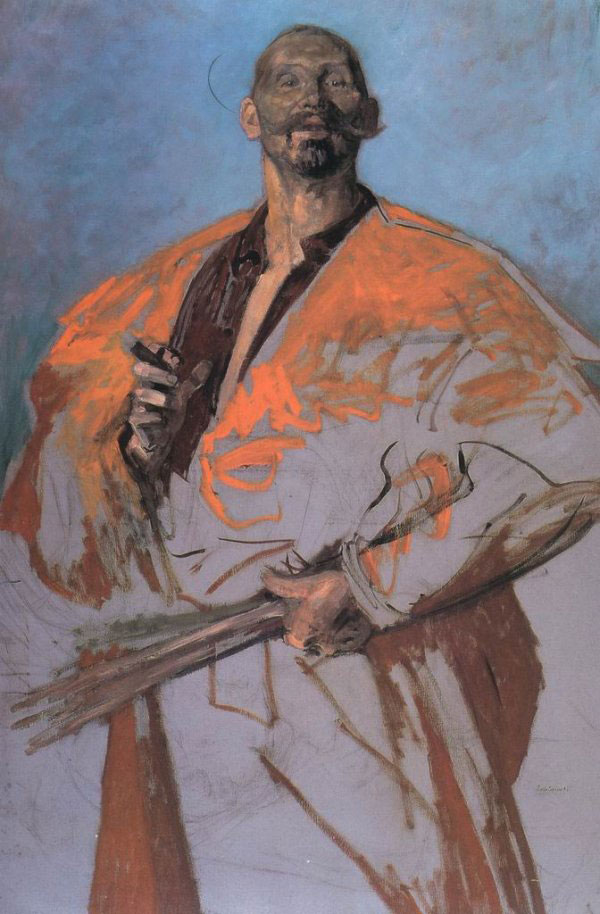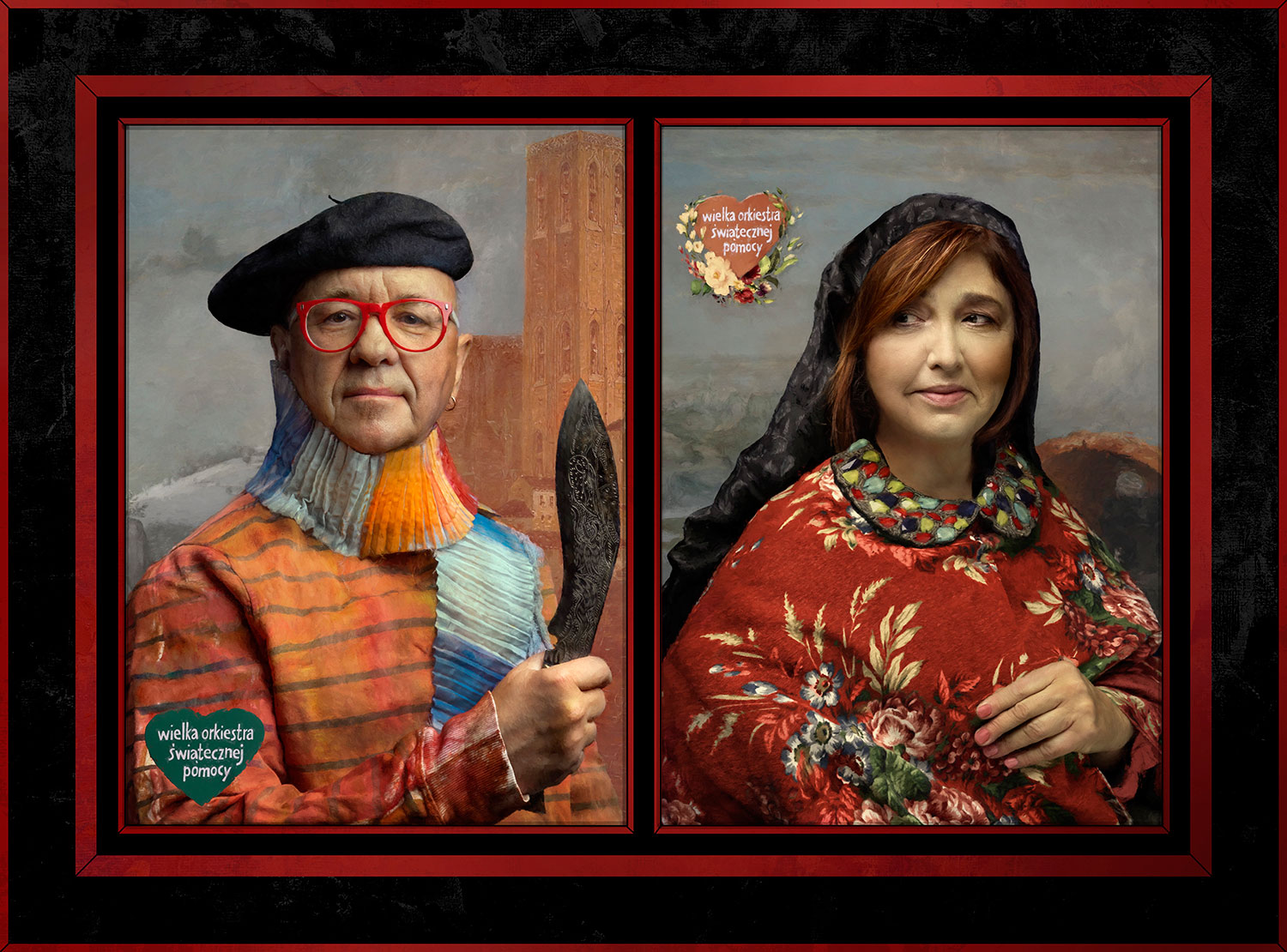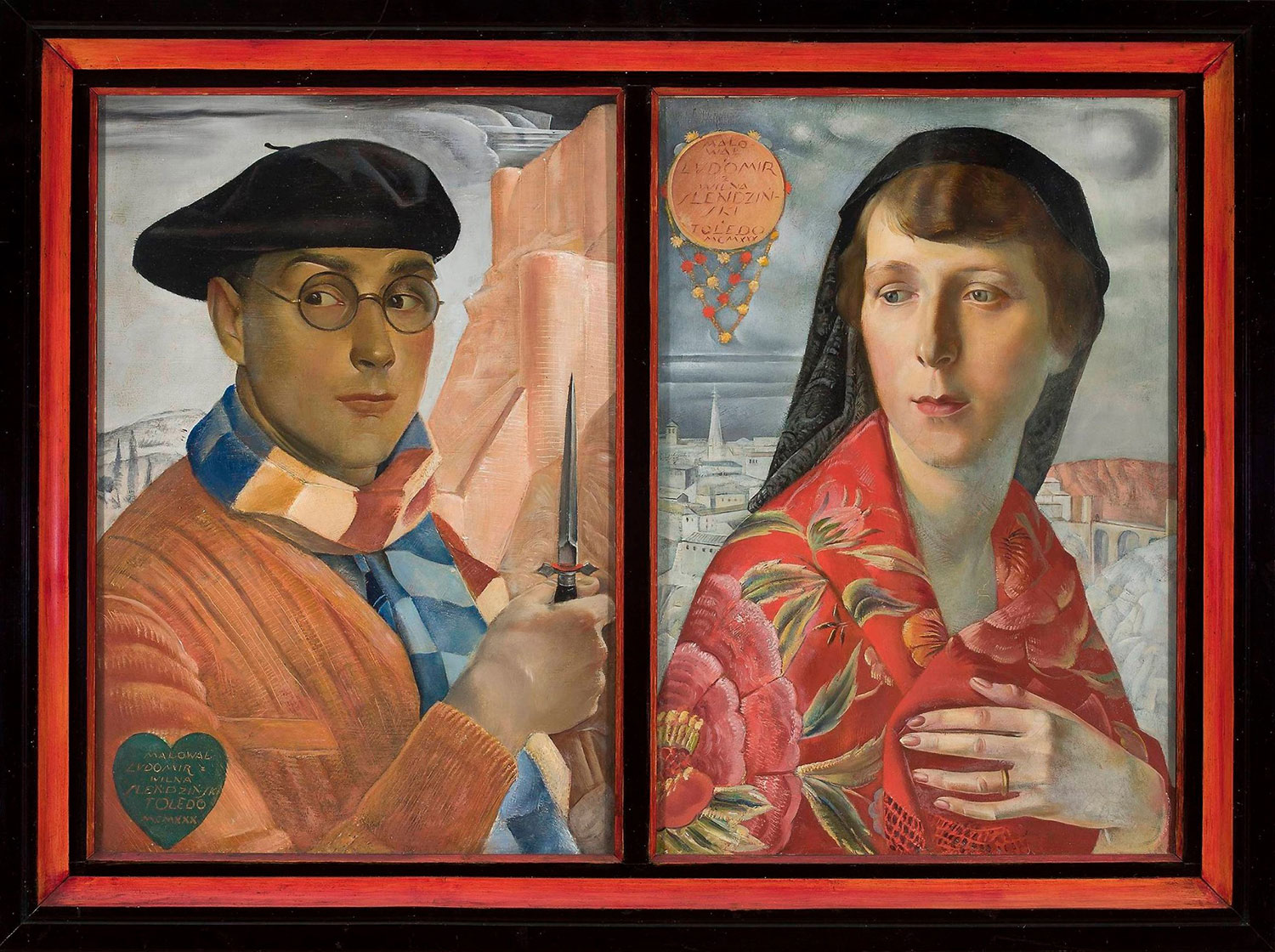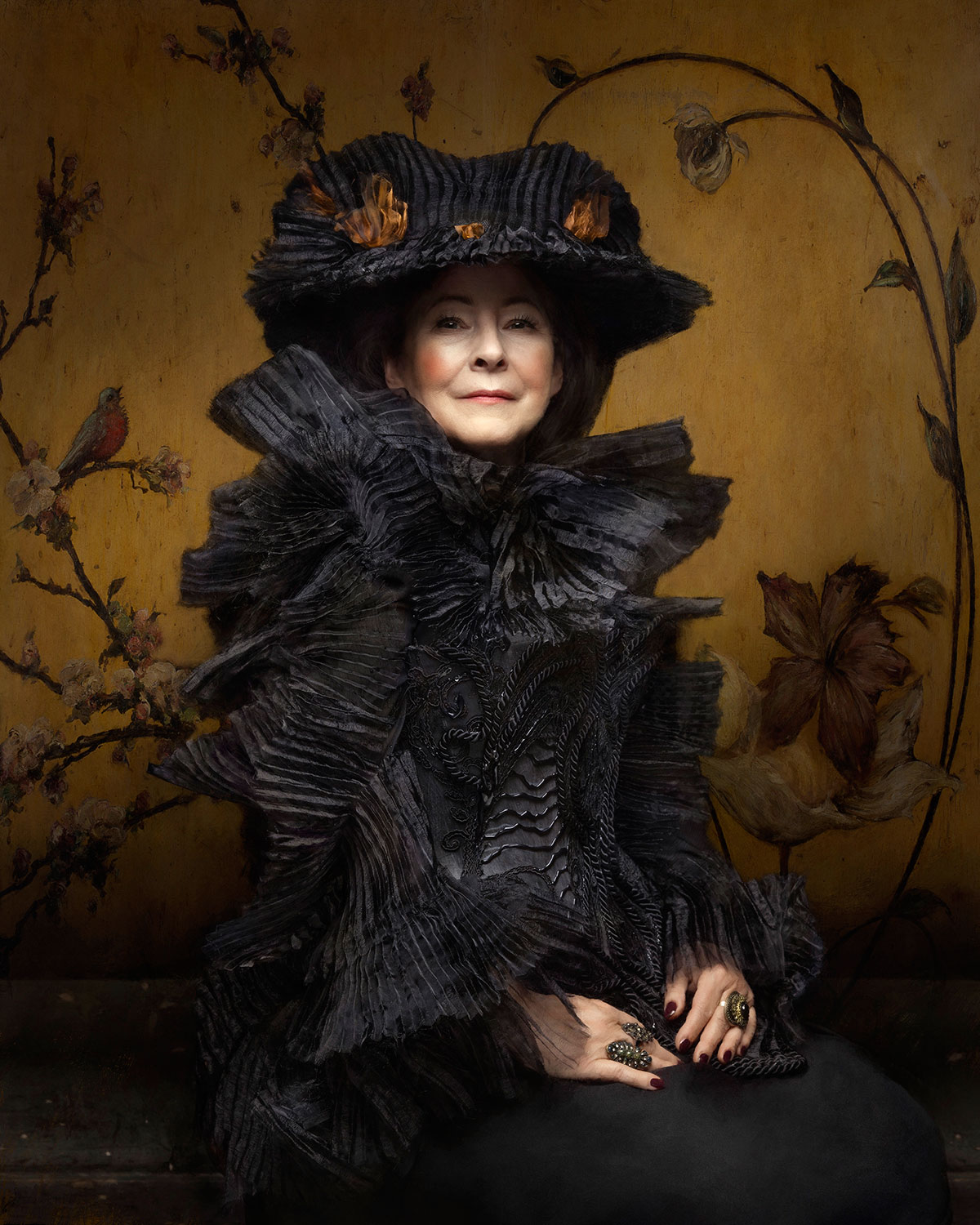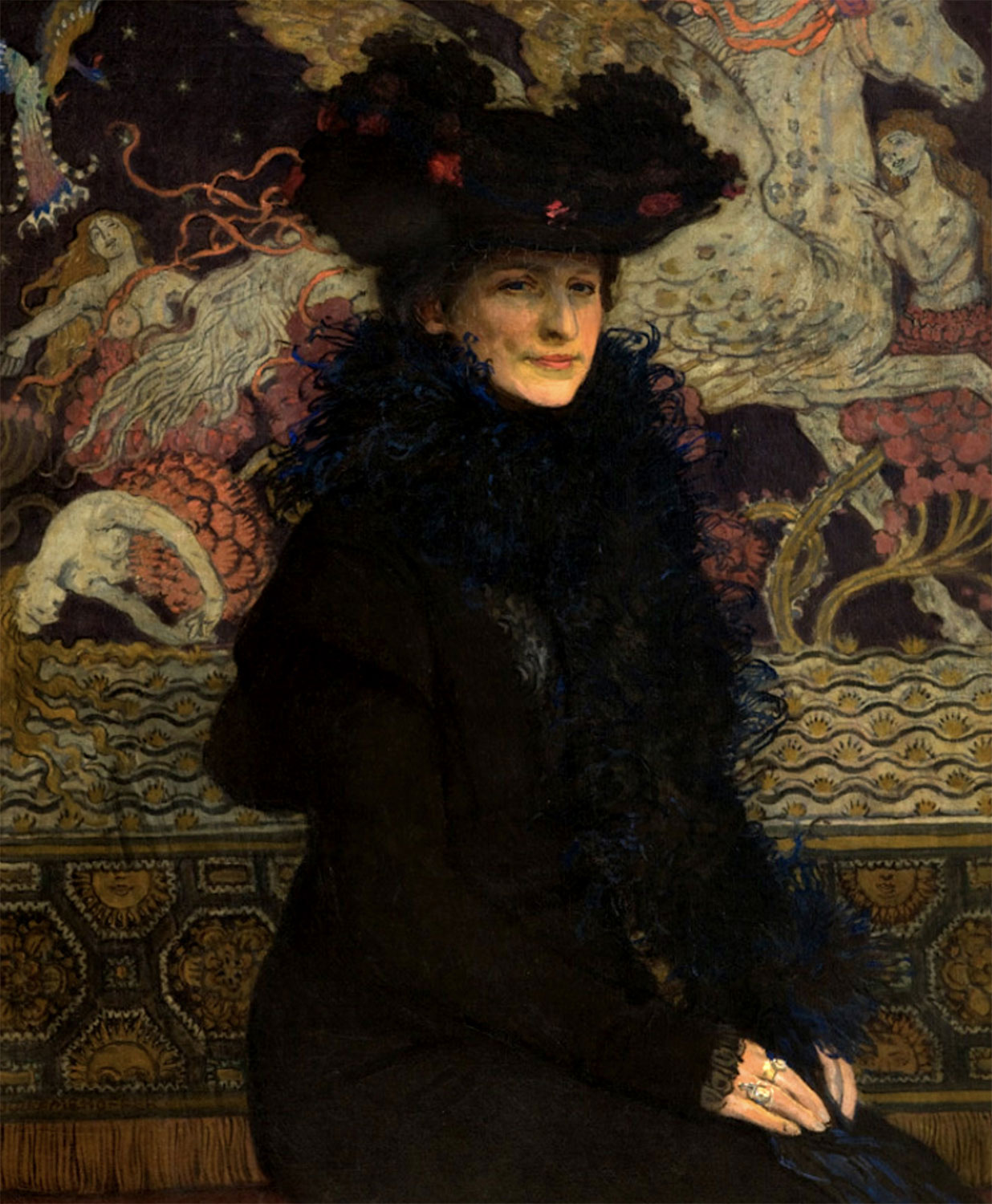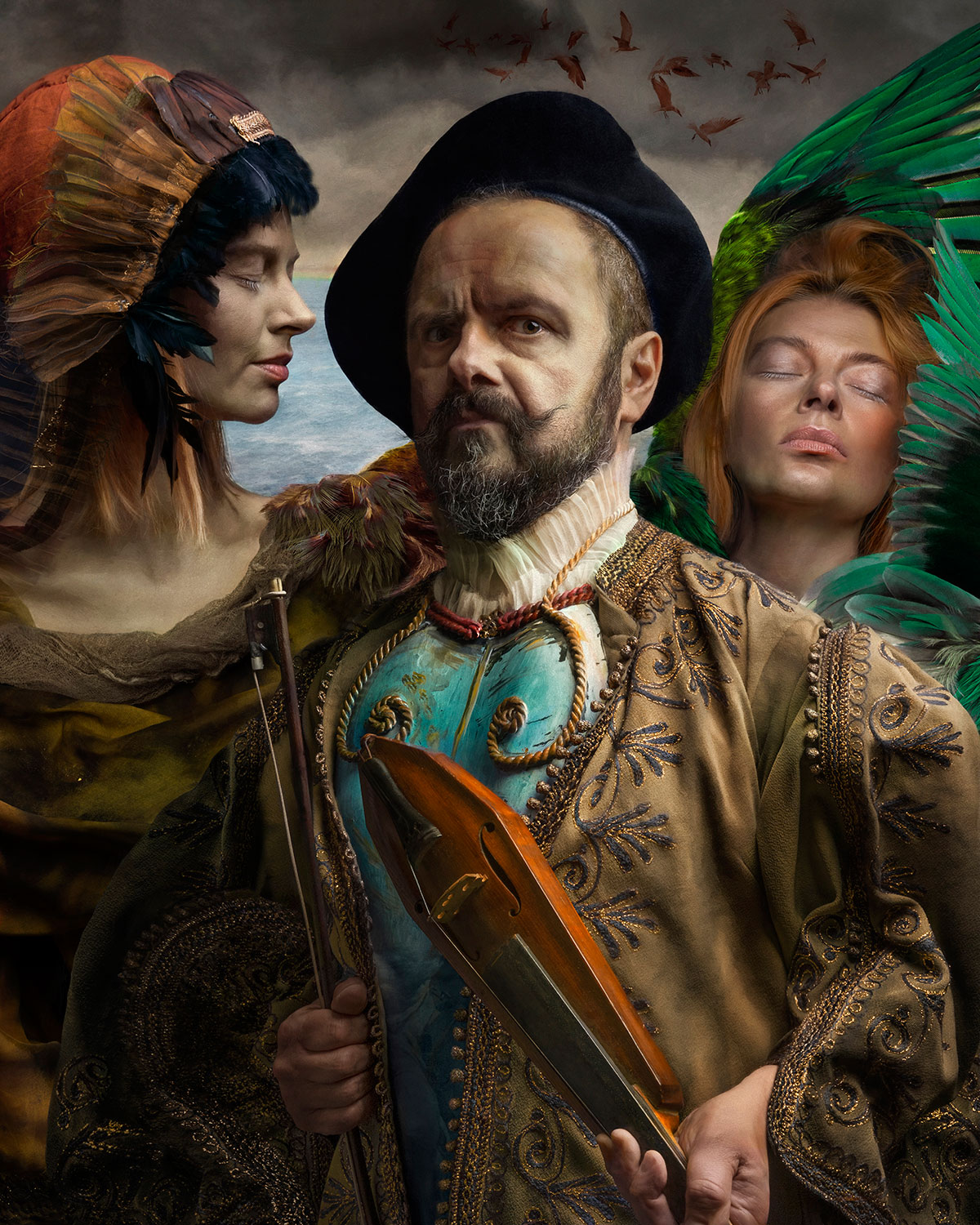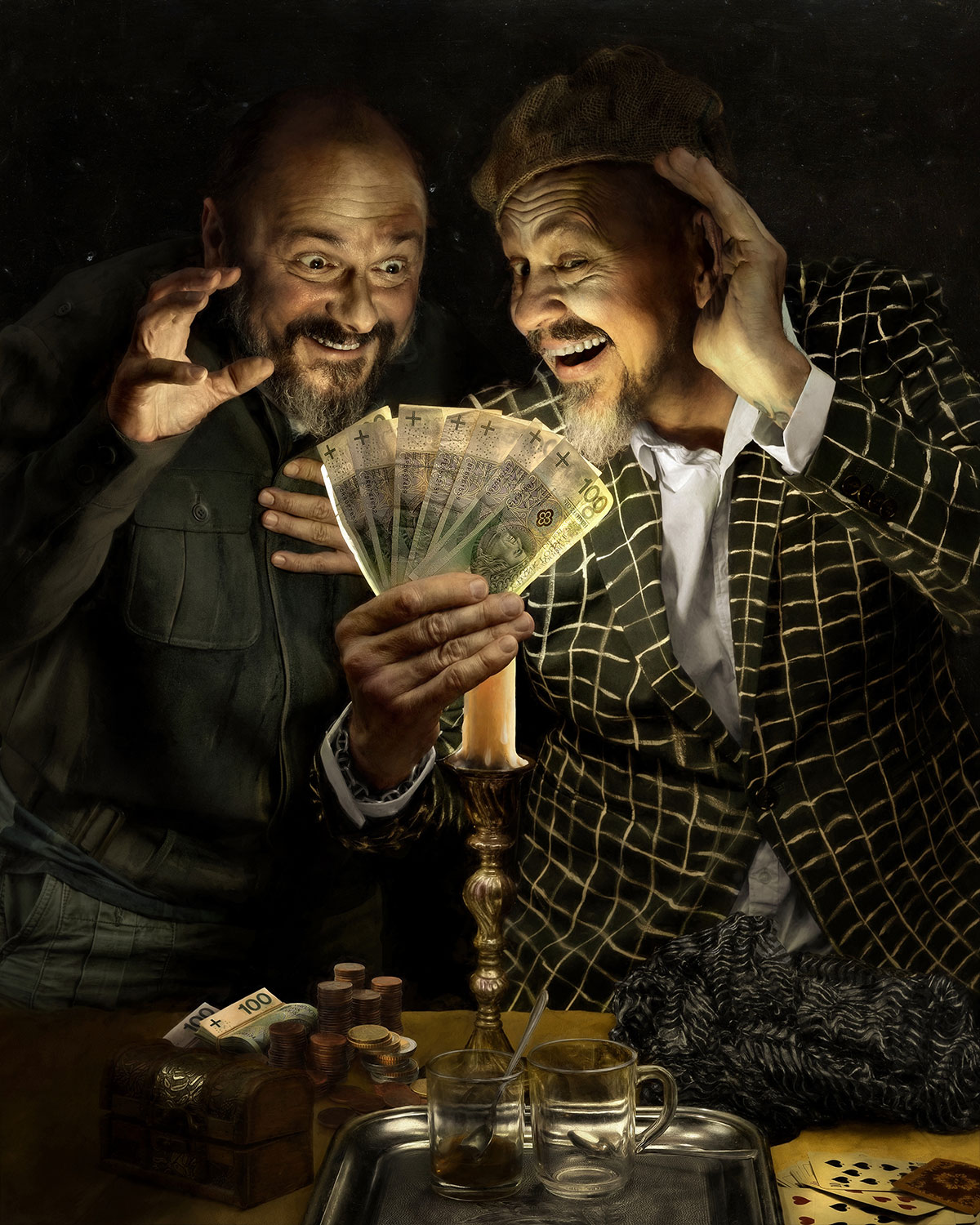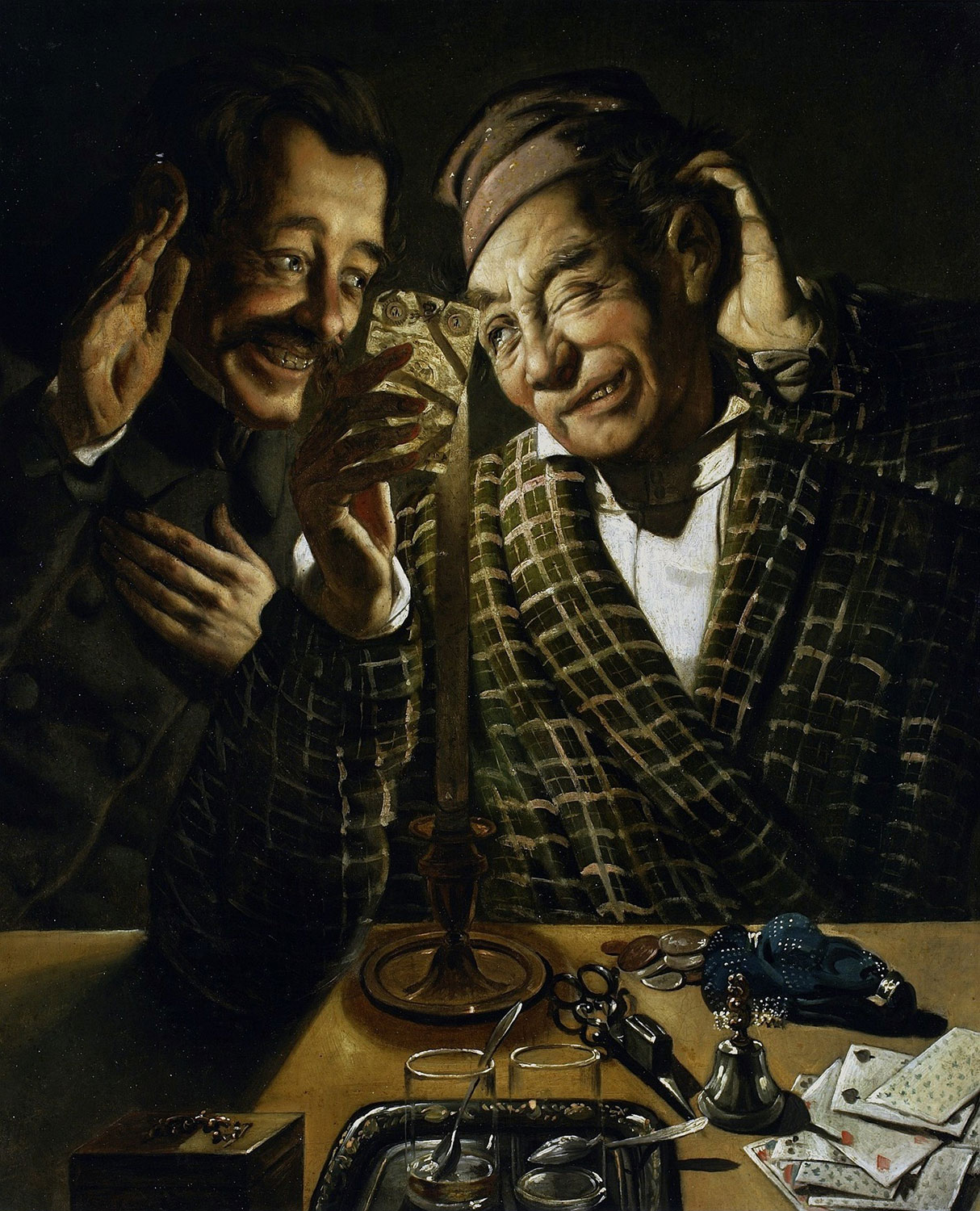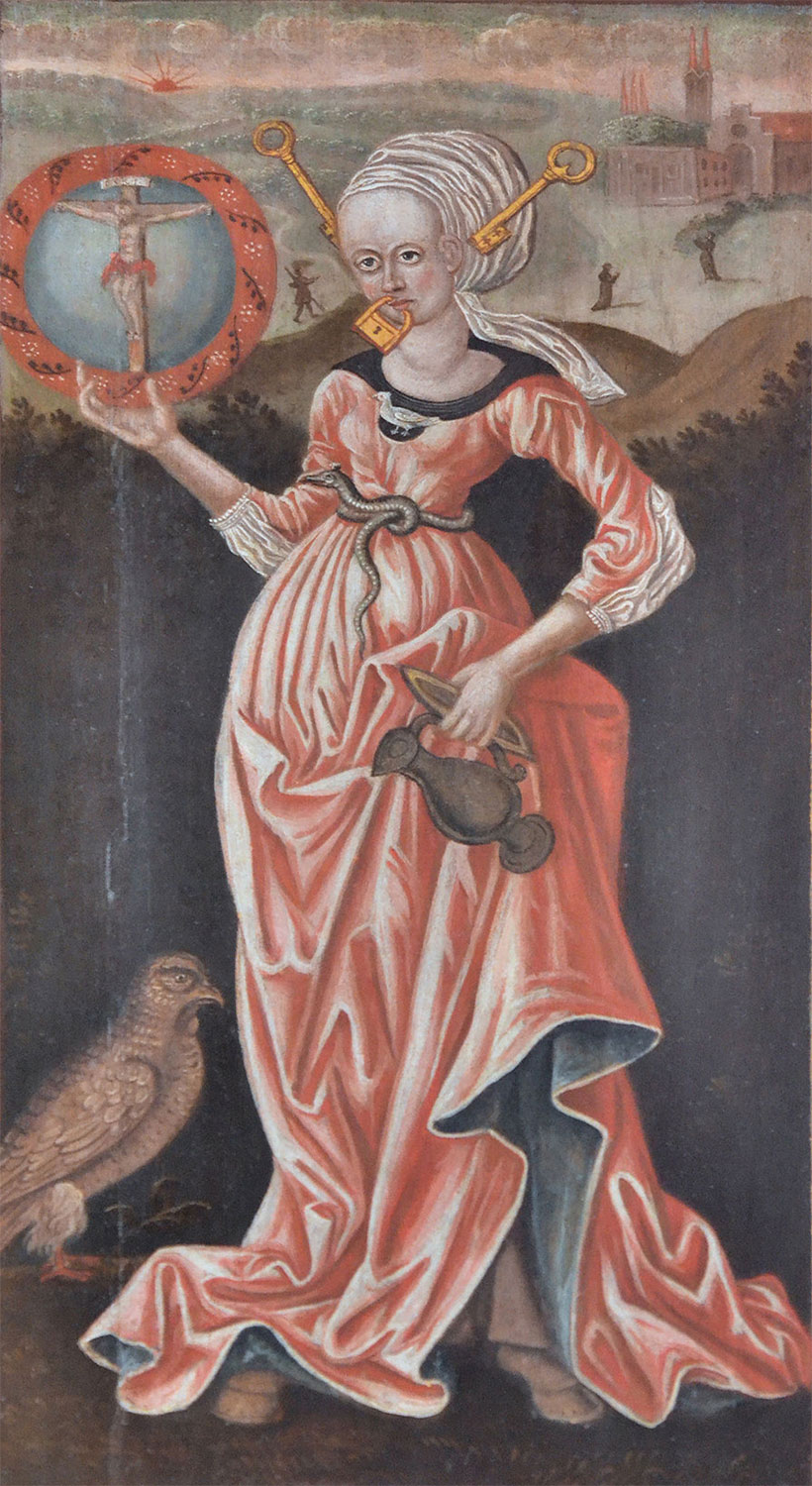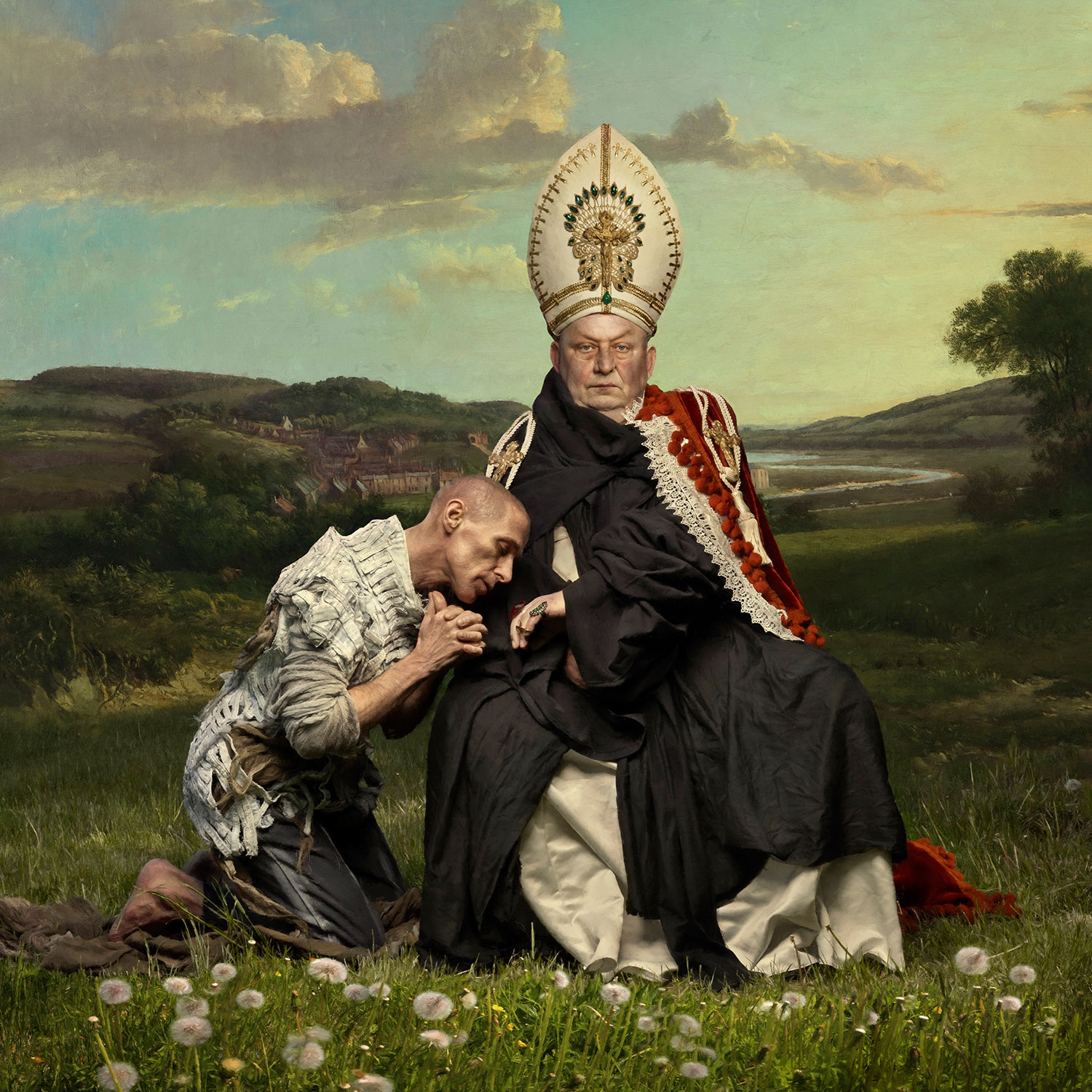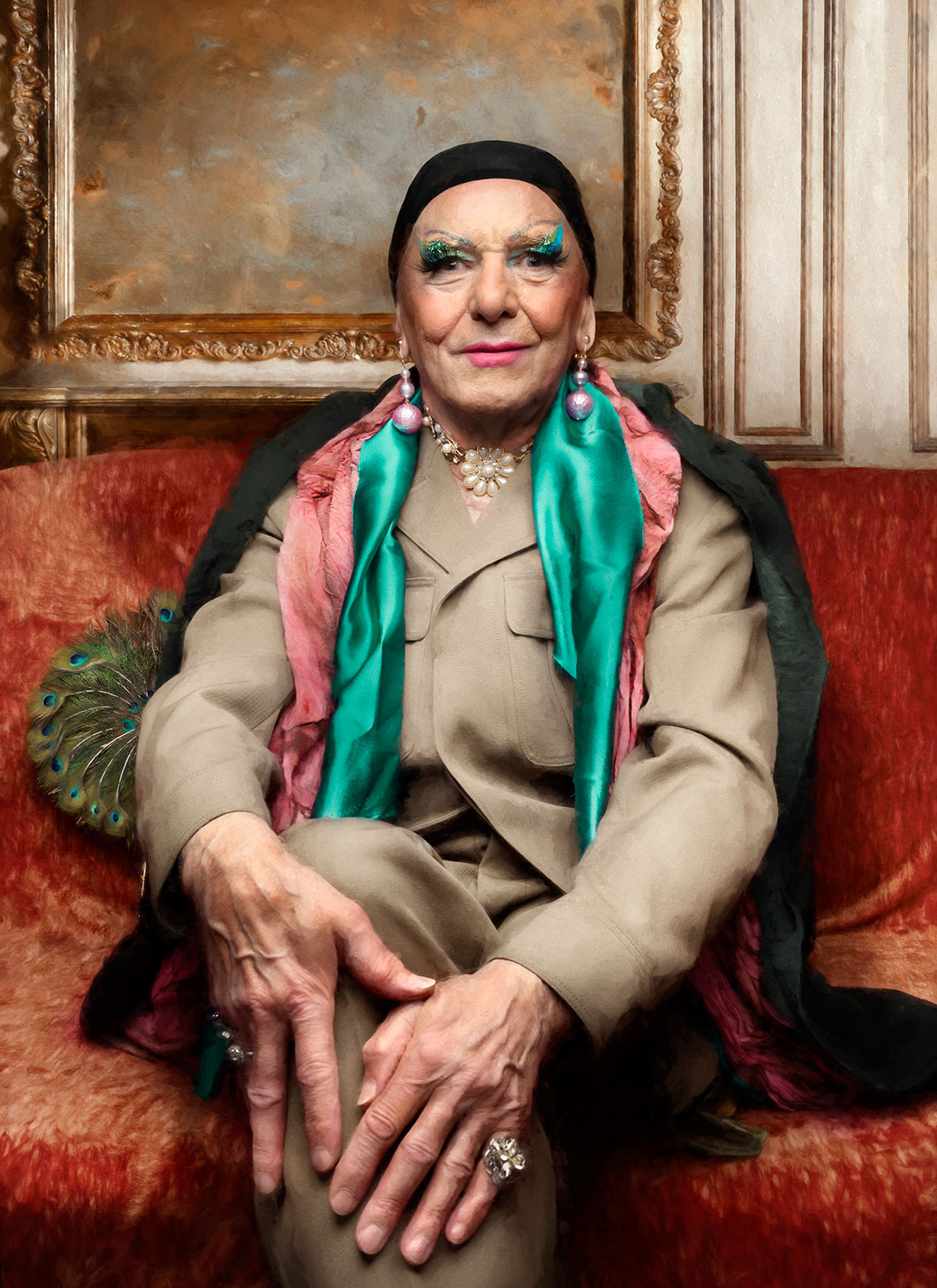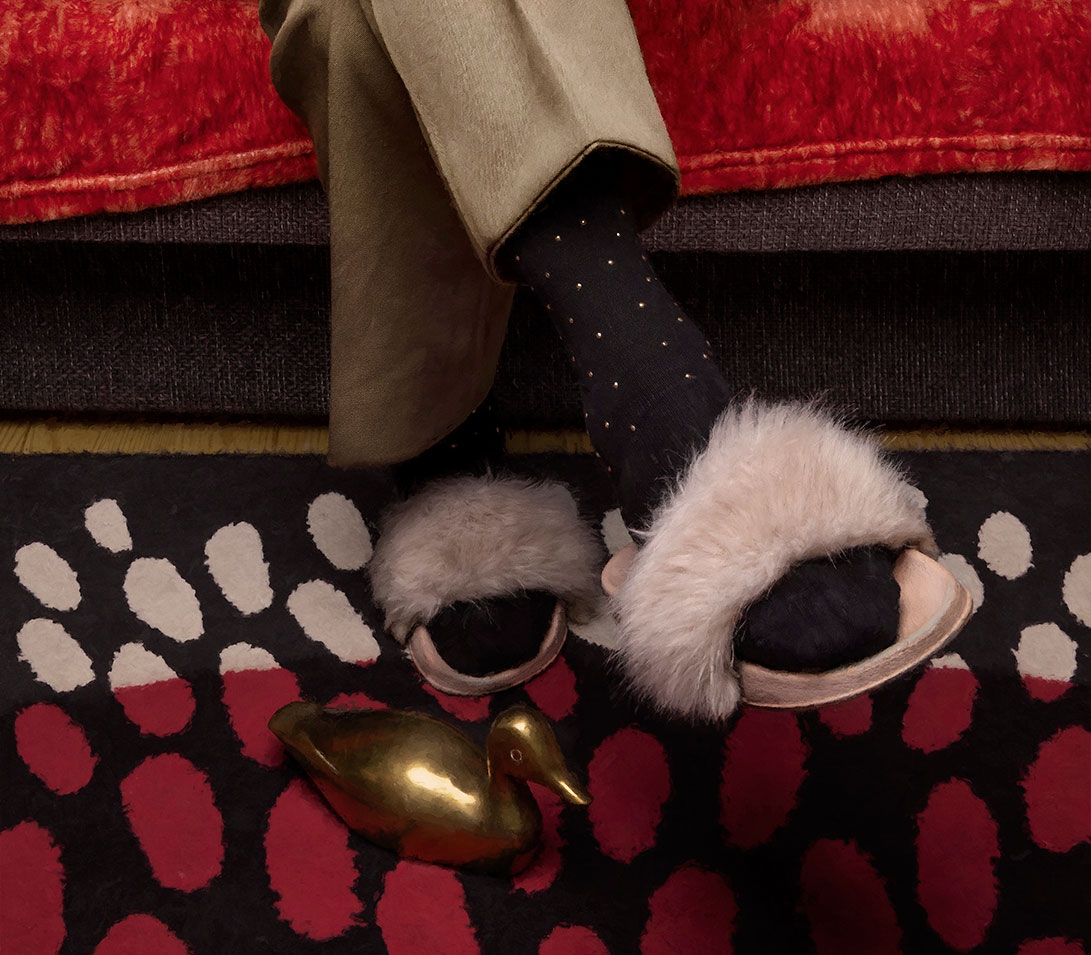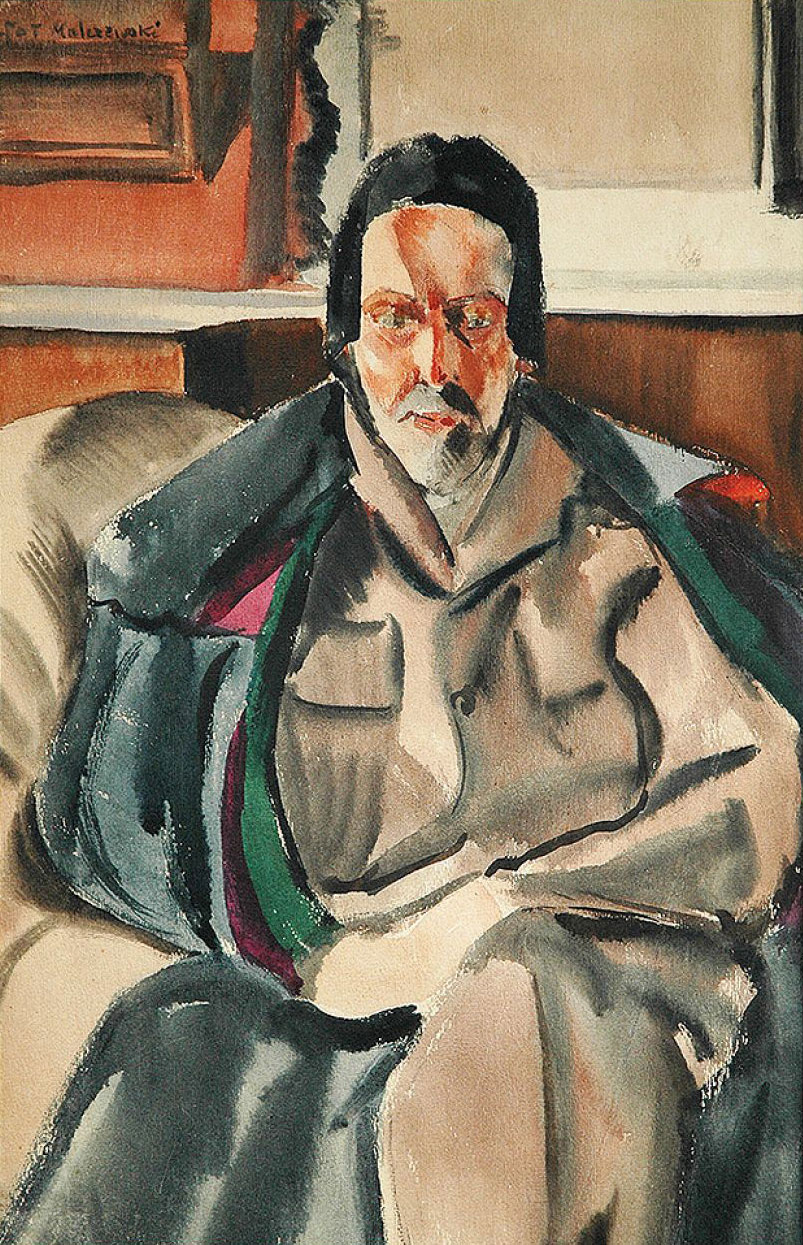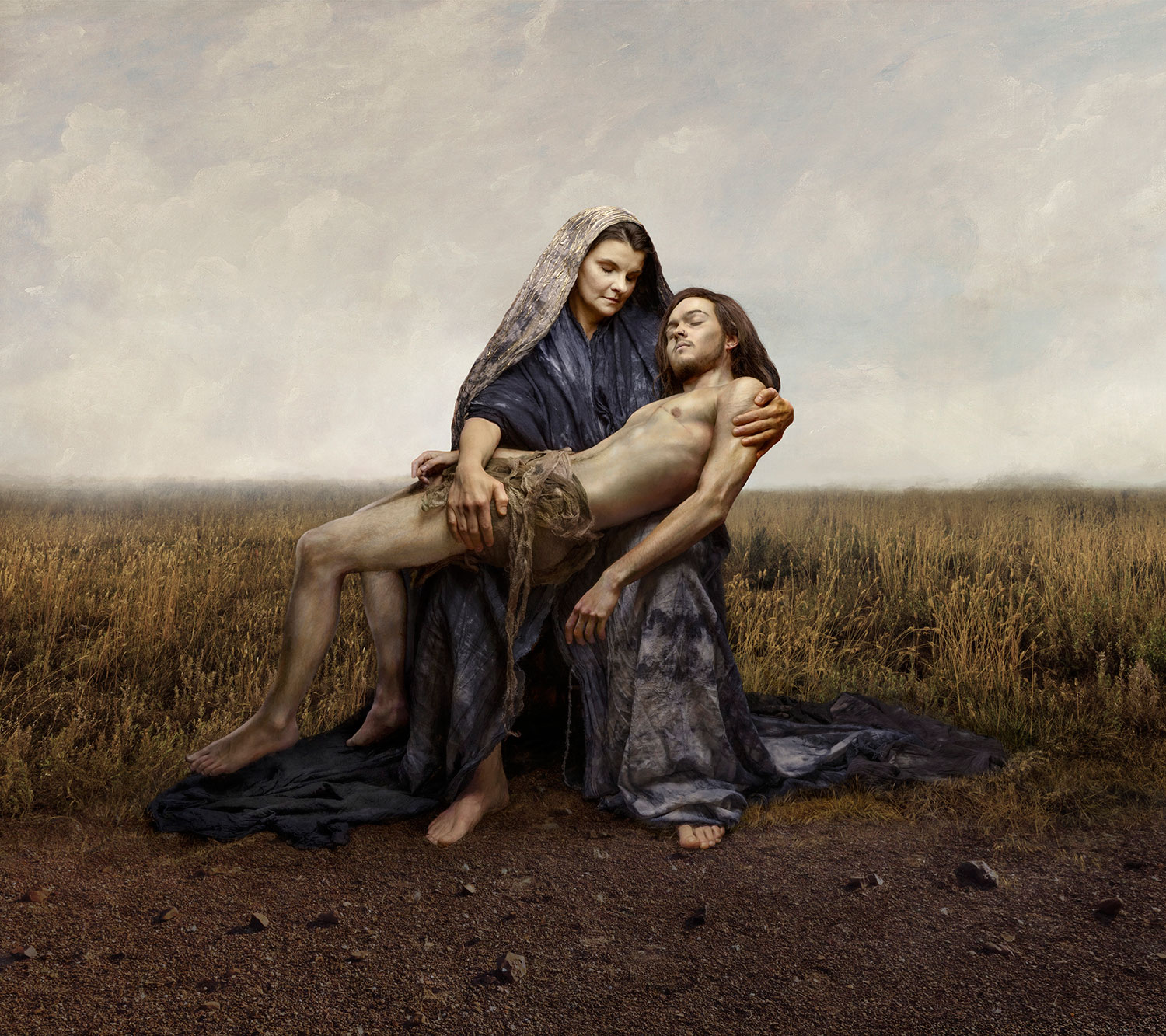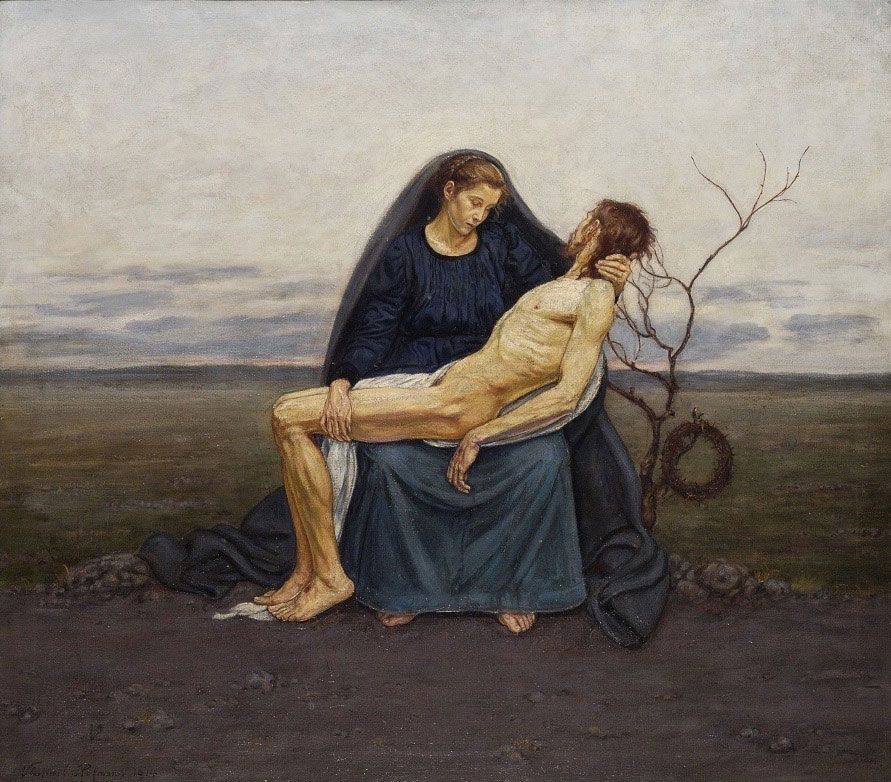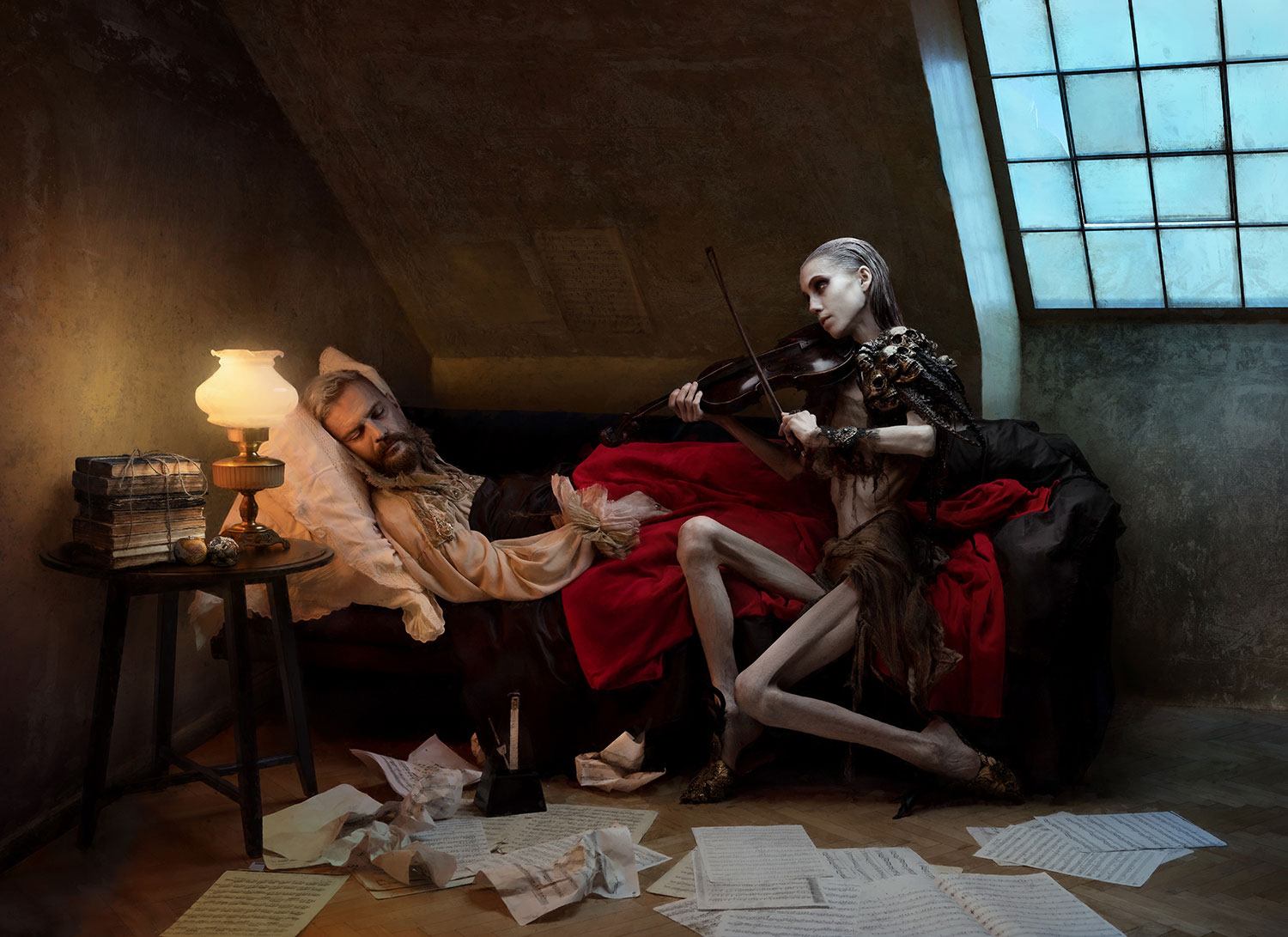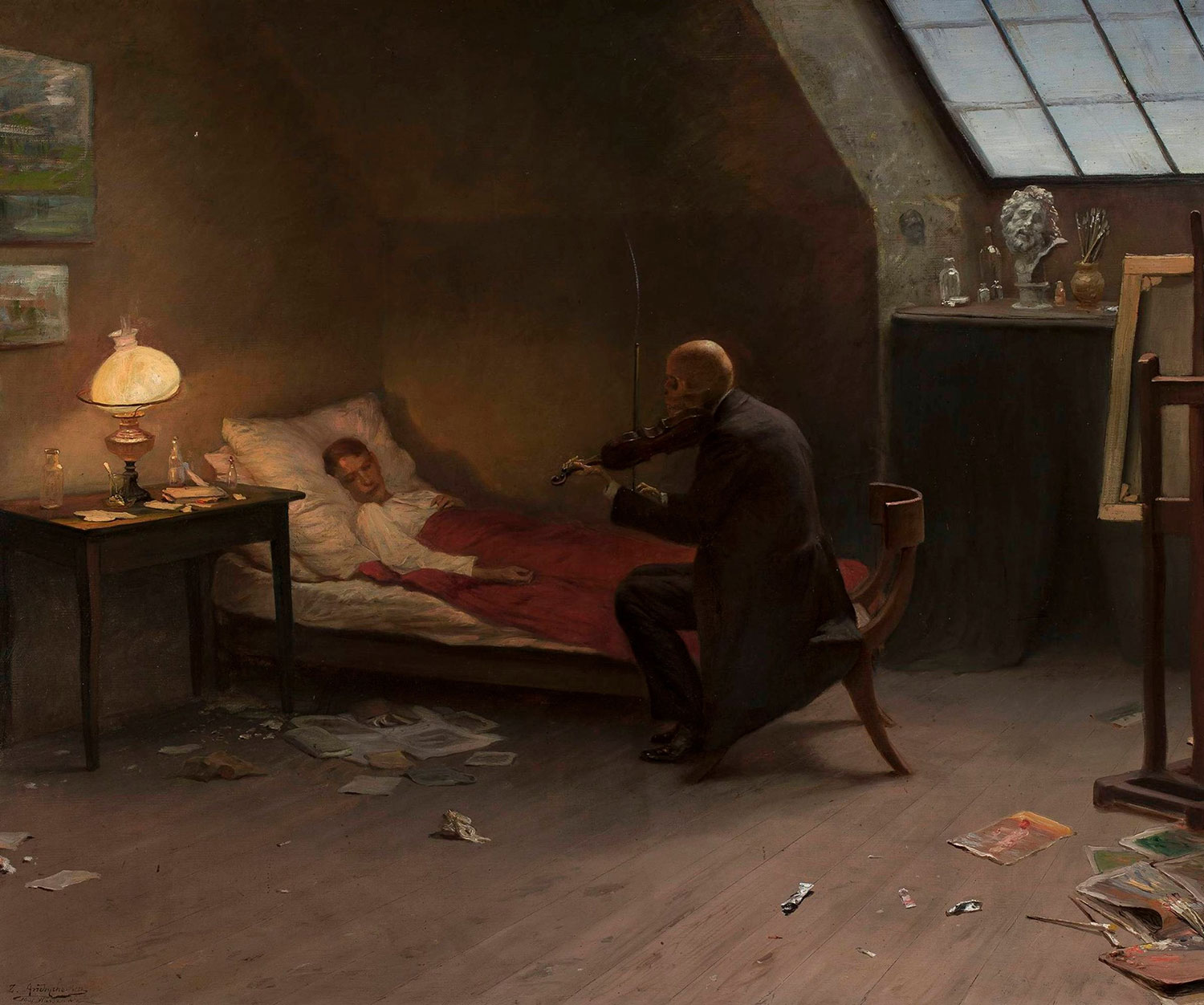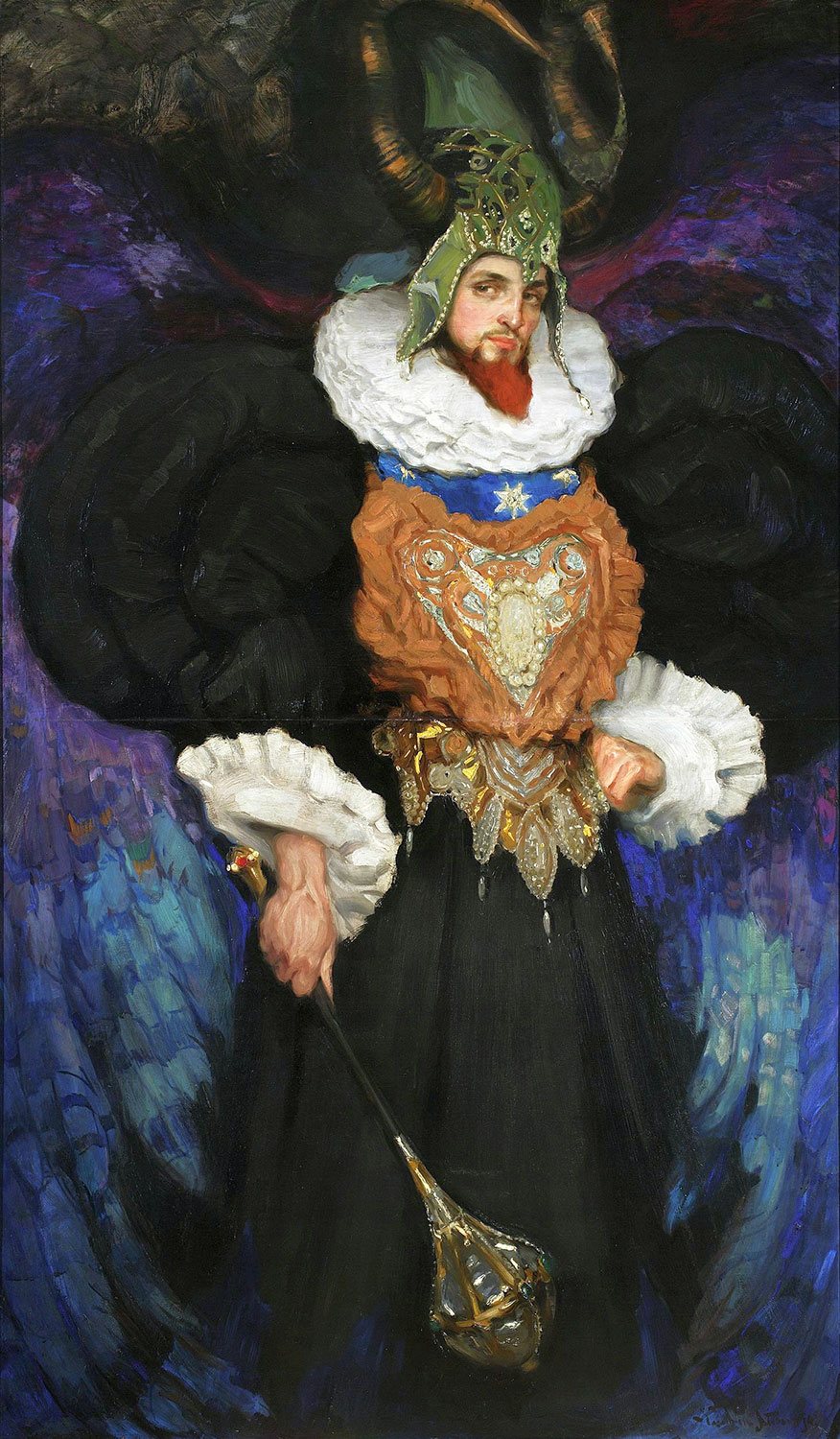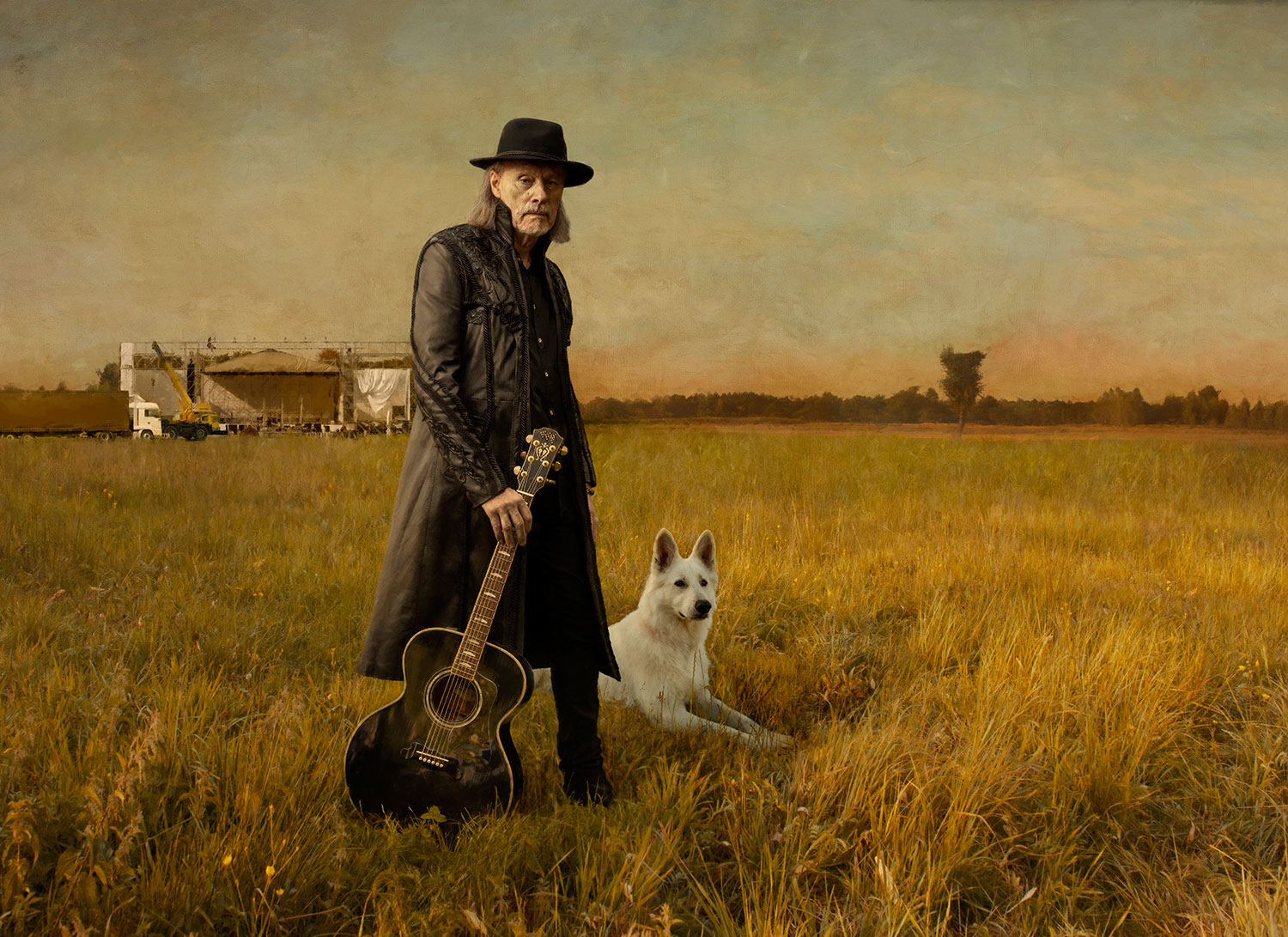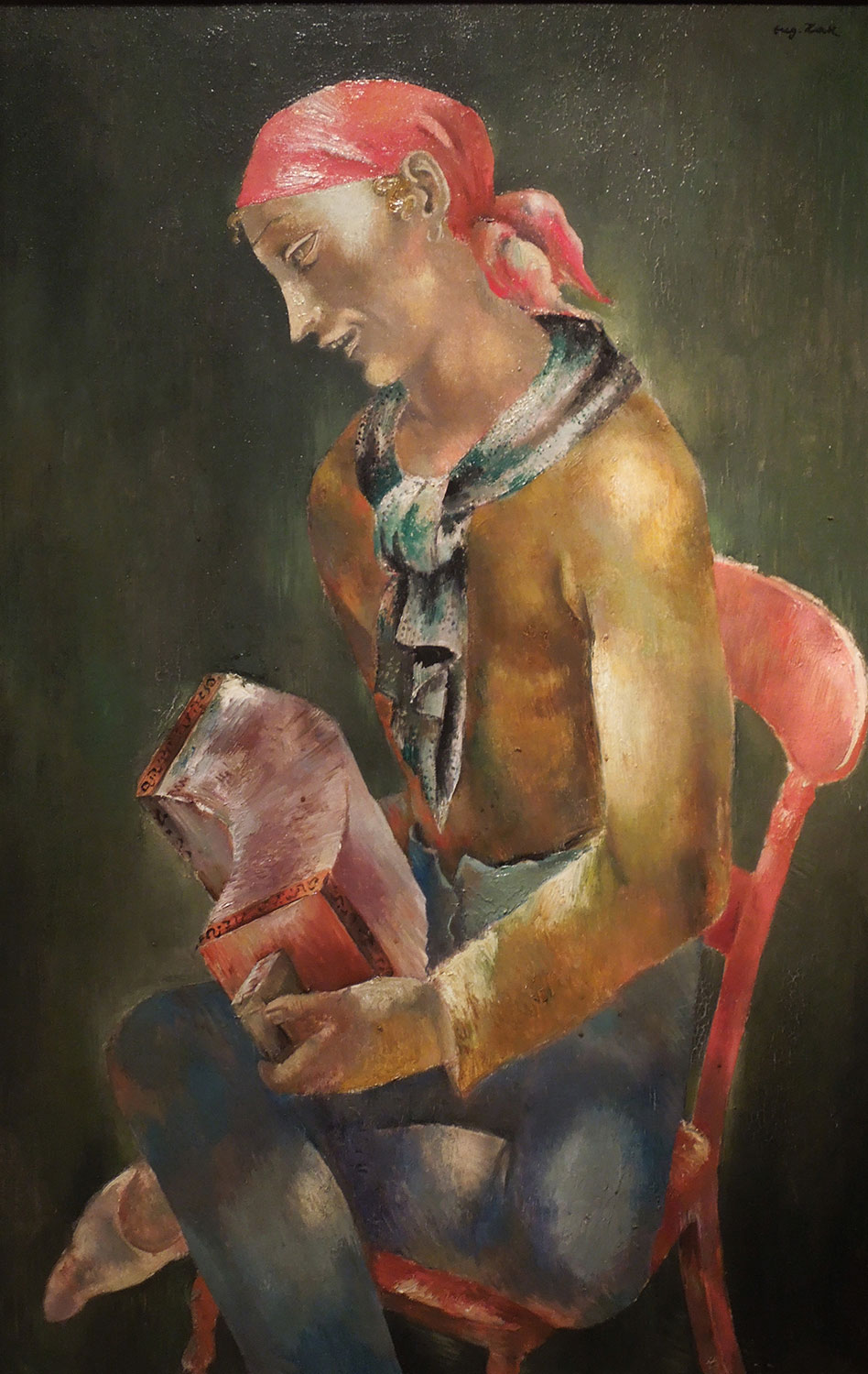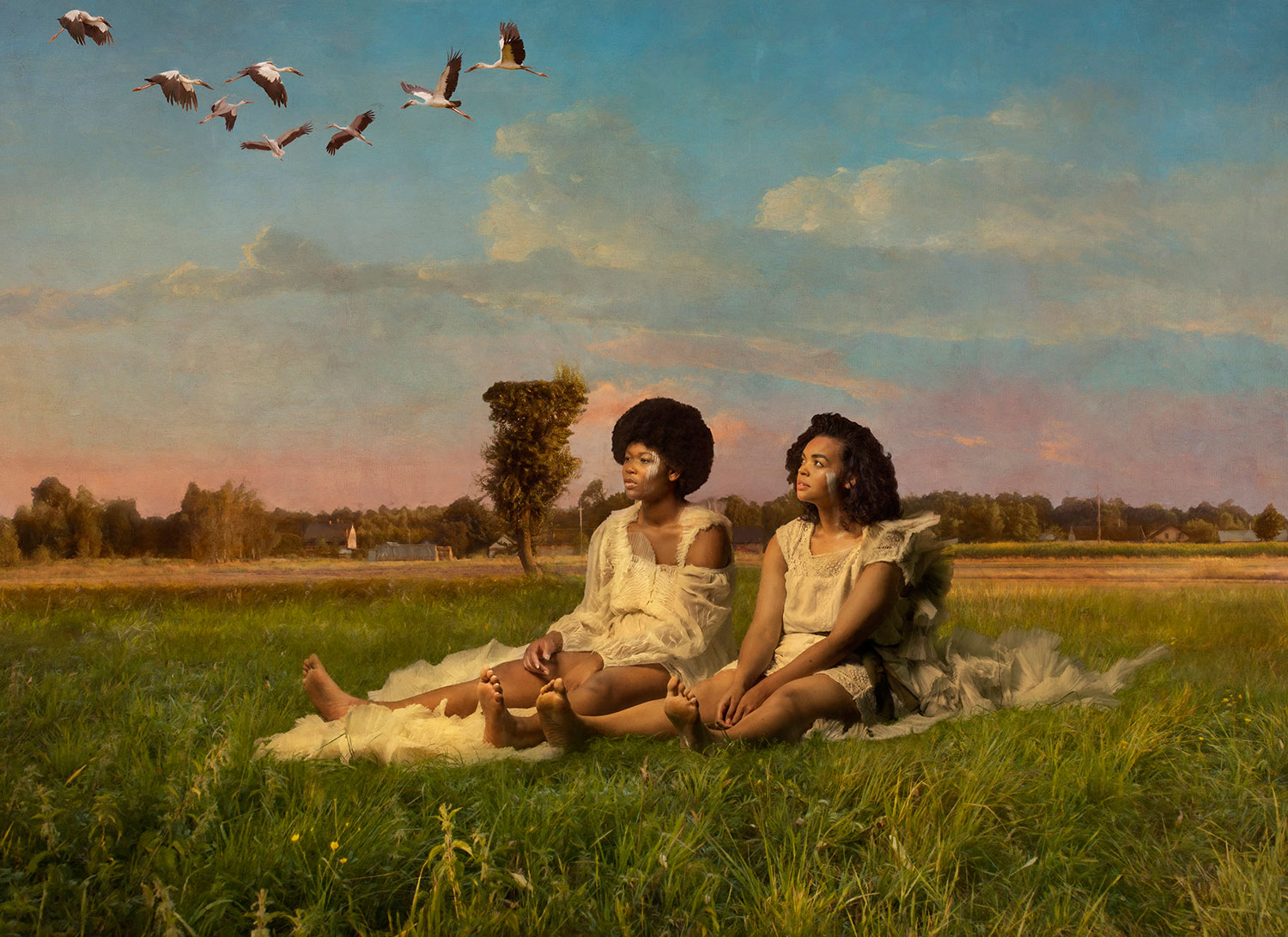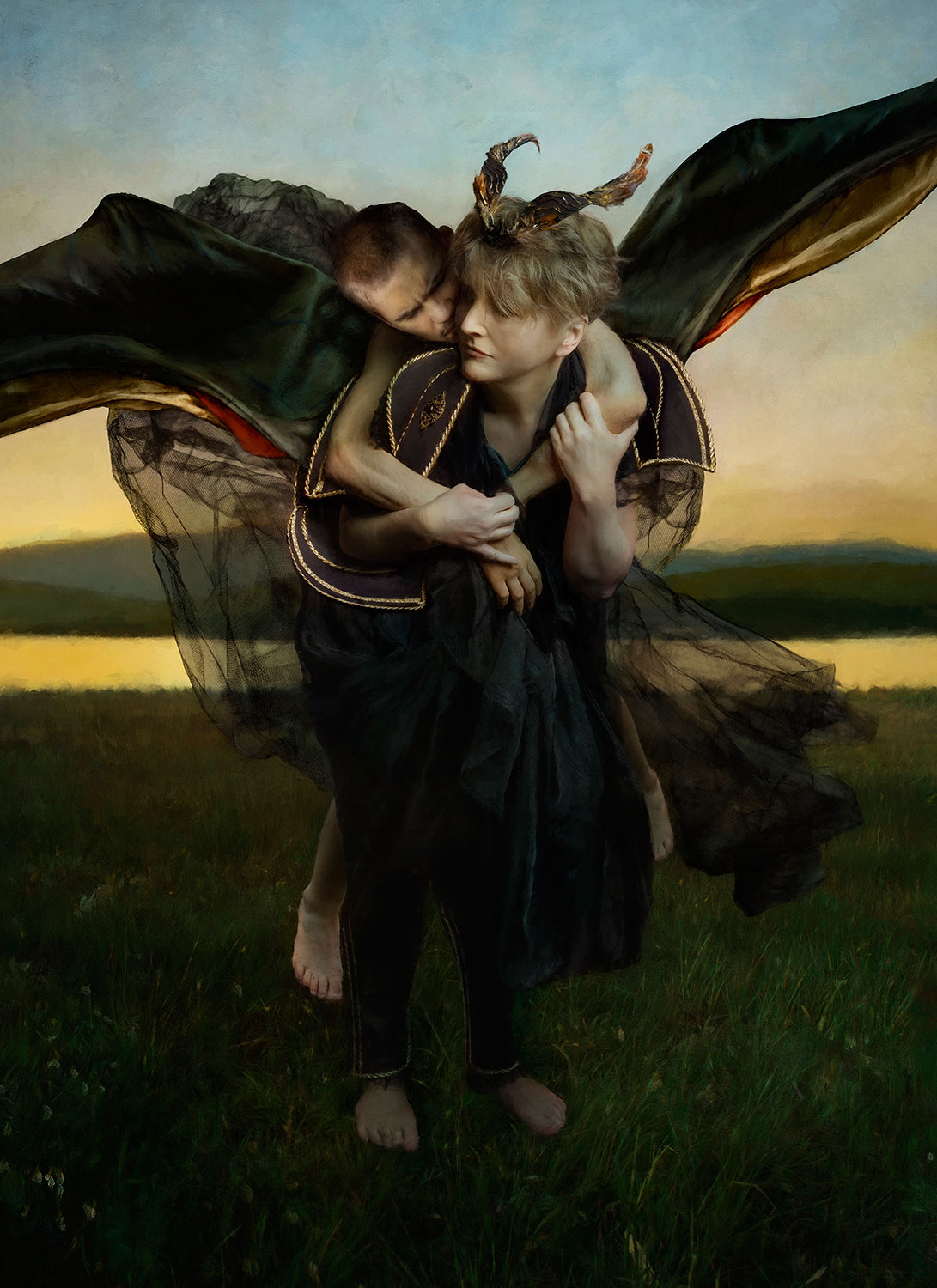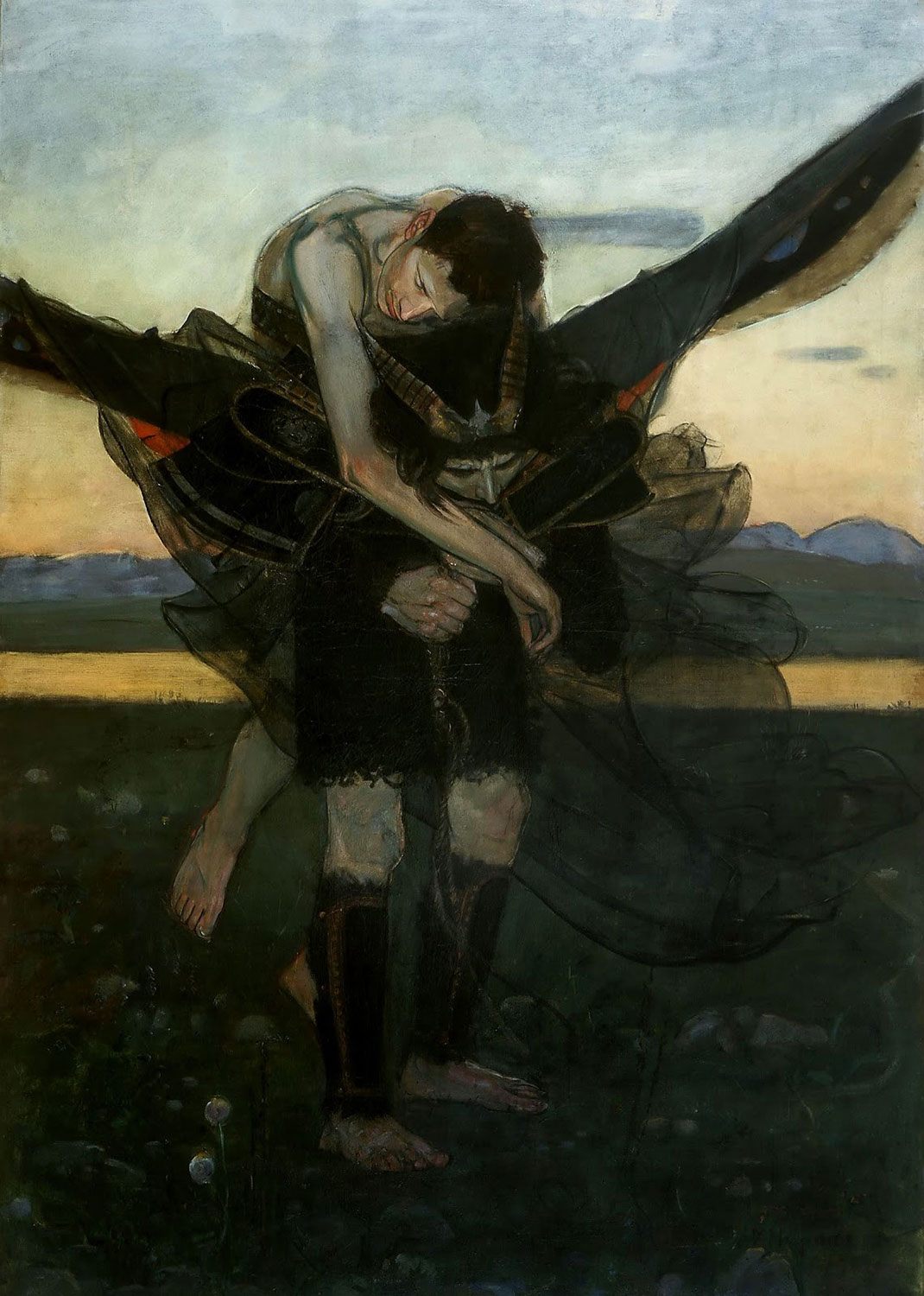"Paint so that Poland may rise again"
Quote: Jacek Malczewski
A series of pictures-photographs that arose out of powerlessness.
"For a long time I watched what was happening in Poland as I was unable to change anything. I saw how all subsequent protests and strikes failed to bring desired results. So at one point I sat down and realized that the best I can do is this exhibition" - explains photographer Sylwia Makris, who lives permanently in Munich.
Quote from the painter Jacek Malczewski came to her mind almost immediately. "He somehow illuminated the way in which I should act," she explains.
For that reason, she invited to her project people of Polish culture who, apart from art, are also close to social and political issues. The group that accepted the photographer's invitation included: Olga Tokarczuk, Jerzy Owsiak, Adam Nergal Darski, Tomasz Organek, Dorota Kolak, Czesław Mozil, and Natalia Grosiak, as well as the feminist activist Katarzyna Bratkowska.
"I saw how many people simply give up and their hope for a change of Polish reality is dying out. In Germany, friends who live here began exchanging passports. Many stated they would never come back to Poland again. They tried to convince me to go the same way. They told me to let it go” - recalls the author.
Despite this, the photographer decided to continue fighting the way she can best - with the image. She presented her heroes in photos inspired by the best Polish painting. They include works by Jacek and Rafał Malczewski, Eugeniusz Żak, and Józef Mehoffer, among others.
"From the start I wanted to show that, despite the difficult situation and many bad things that are happening in Poland now, there are still many fantastic people here who do amazing things, fight all the time, and do not intend to give up." - emphasizes Makris .
Each photo has its own story and message, but they all look at current and relevant issues such as depression, tolerance, faith, emigration, and the value of art. Together they create a beautiful, if at times difficult picture of what, as a society, we need to work on. At the same time reminding us how great Polish culture is, how much we owe to it, and how much we can still draw from it.
Texts: Estera Prugar
English translation: Michał Majkowski
Exhibitions
12-31.07.2022 Kunsthalle München
29.07 - 31.08 2021 Pol’and’rock - Makowice
6.08 - 15.08 2021 Gdańsk Plenum
6.10 - 10.10 2021 All About Freedom Festival - Europejskie Centrum Solidarności
"Leon Wyczółkowski", Jacek Malczewski - Jurek Owsiak
"Portrait of Leon Wyczółkowski" was painted by Jacek Malczewski around 1895. The former is recognized as one of the main representatives of the Young Poland, the latter as an outstanding and leading representation of Polish symbolism at the turn of the 19th and 20th centuries.
They met in Kraków, although they both came from Mazovia. Wyczółkowski, who is two years older, started artistic education in the Warsaw Drawing Class, where after two years he changed from Antoni Kamieński’s and Rafał Hadziewicz’s classes to the ones lectured by Wojciech Gerson, under whose wings studied, among others, Józef Chełmoński. In his painting, Gerson took a realistic direction and focused on historical and religious themes.
It was under his influence that Wyczółkowski painted a series of images depicting saints. One of these paintings, Saint Casimir and Jan Długosz", was exhibited in the Society for the Encouragement of Fine Arts in Warsaw (Zachęta). This became the first artistic success for the then twenty-one year-old painter.
“Wyczółkowski in Malczewski's painting is not only painted, but also outlined in pencil, which gives the effect of both finished work and one that is continuously under creation. It reminded me of the activities of Jurek Owsiak – he has created beautiful things that have not only functioned for years, but have also constantly evolved, this way they will last ‘until the end of the world and one day longer’” - explains the photographer Sylwia Makris.
Jacek Malczewski today remains one of the most acclaimed artists in the history of Polish painting. His interests revolved around several topics which were constantly ‘in motion’, viewed from different perspectives, as he explored and kept bringing out further aspects of the same issue. The same motif appeared repeatedly in his works under multiple variations.
He painted hundreds of portraits. Among these, the group of works that particularly stands out, are those containing faithfully painted figures of the model, which occupies the largest part of the foreground. It creates an illusion, thanks to which the recipient can feel the physical presence of the hero, this way reviving the life locked in the picture.
A recurring theme of death began to appear in Malczewski's work after his father's passing in 1884. A year later he left for Munich and after another two years he married Maria Gralewska, the daughter of a pharmacist from Krakow. The couple had two children: a daughter Julia and a son Rafał, who later followed in his father's footsteps and also became a renowned painter. Malczewski was involved in pedagogical work for many years. He was also strongly drawn to educational activities- as a co-founder of the Society of Polish Artists "Sztuka", he wanted to improve, in his opinion, the declining level of art in Poland, as well as "contribute to growing the artistic life of the country’’. The latter postulate was included in the objectives of the Society.
“He is a deep poet and huge painting talent, outstanding to the very bottom, the two traits united in one man. Sometimes it is regrettable that from this profound poetry, from this wealth of thoughts and feelings, nothing more can be known other than what his pictures show with great talent, but with constraints stemming from the very nature of the art of painting, “wrote Stanisław Witkiewicz-father about Jacek Malczewski. Years later, the paintings of the artist's son, Rafał Malczewski, were reviewed with similar admiration by Witkacy.
Malczewski, the father, once said about himself that "if I was not a Pole, I would not be an artist", and he was to advise his students one day after finishing their painting consultations: "Paint so that Poland may rise again".
Text: Estera Prugar
"Double Portrait", Sleńdziński Ludomir - Jurek i Lidia Owsiak
Polish painter, sculptor and teacher; dean and vice-dean of the Stefan Batory University in Vilnius (1929-1939) and rector of the Cracow University of Technology (1948-1956) - Ludomir Sleńdziński was born in 1889 in Vilnius.
At the age of twenty, he entered the Academy of Fine Arts in St. Petersburg where, after six years of study, he received his diploma. In 1920, after eleven years, he returned to his hometown, already as a well-known figure in the artistic world. He accepted the position of a teacher in a secondary school, and organized Vilnius Society of Artists and Designers.
In 1924, at the opening of an exhibition of the Vilnius community in Warsaw, Sleńdziński met Irena Dobrowolska. The artist left for Italy shortly after their meeting. Despite the fact that the couple spent little time together, the feeling between them was so strong that, after his return, the painter proposed to his beloved in front of a painting by Jan Matejko, entitled "Batory at Pskov" at the Society for the Encouragement of Fine Arts in Warsaw.
“While looking for paintings for other heroes of the project ‘Paint so that Poland may rise again’, I came across Sleńdziński's ‘Double Portrait (Artist with Wife)’ and without thinking, I immediately knew it had to be Jurek and Lidia”- admits Sylwia Makris. The photographer immortalized Jerzy Owsiak and his wife Lidia Niedźwiedzka-Owsiak in her painting.
Even after the proposal, Dobrowolska and Sleńdziński were not to spend many moments together - the young artist had another trip planned, this time to Paris. While in France, he wrote almost every day to his fiancée, whose image was already then immortalized in his paintings. It was during this period that he wrote, among others, "Portrait of a wife with a wedding ring in a blue beret," for which three years later the creator received the Academy of Learning award, and the work is still called "Bialystok Mona Lisa".
“I looked at ‘Double Portrait’ and thought about the unity of two people. Ms. Lidia is with Jurek all the time, although she may seem less visible, everything they do they do together. There is a great power of cooperation but also the power mutual support”- says Makris.
The Sleńdziński couple settled in Vilnius. During World War II, the painter and his family were thrown out of their apartment, arrested, and in 1943 imprisoned together with other prominent Vilnius residents in the heavy labor camp in Prawieniszki, located in today's Lithuania.
After the war, the artist decided to move to Krakow, where he joined the Faculty of Architecture and took over the department of drawing and sculpture. Nine years later - in 1954 - he was appointed the first rector of the Krakow University of Technology. He held this position for six years before retiring, afterwards he devoted himself entirely to painting.
The painter came from many generations of artistic family. His great-grandfather, Aleksander Sleńdziński, was a painter and drawing teacher, who also showed musical talent and played the Hungarian flute. His skills were inherited by one of the three sons - Wincent. It was him who, after his wedding, took care of the children from his wife’s Anna first and second marriages. Then the couple had two children of their own: a daughter, Johanna, and the youngest son - Ludomir, another future artist.
Ludomir Sleńdziński and his wife had one child, the daughter, Julitta Anna, who was the first to take full advantage of the family's musical predispositions. She graduated from the Mieczysław Karłowicz Music School of Vilnius and became a pianist and the winner of a distinction award at the Chopin Competition in 1949.
Text: Estera Prugar
"Strange garden", Józef Mehoffer – Natalia Grosiak
One of the most recognizable works by Józef Mehoffer, entitled "Strange Garden", started to be created in 1902 in Siedlec near Krakow, where the painter rested with his family. The painting however was only finally finished a year later. It shows three figures: the artist's wife, painter Jadwiga, their two-year-old son Zbigniew, and the child's guardian.
“In the new version of ‘Dziwny Ogród’ I perform with my daughters, who will inherit this world from me” - explains the singer and songwriter Natalia Grosiak.
The image of Jadwiga Mehofferowa can be found in many of her husband's paintings. The couple met in 1884 in Paris, where - still then - Jadwiga Radzim-Janakowska was staying with her sister Wanda. Before that, they both graduated from painting studies in Munich, but the younger sister was closer to music, while Jadwiga stayed with the painting.
Natalia Grosiak admits that she was pleased to be invited to the project " Paint so that Poland may rise again". “I am a fan of her work, and besides, when she told me about the project, I thought it would be something big. How can you refresh the meaning of Polish painting? Referring to it and interpreting it anew. Great” - emphasizes the singer.
Mehoffer studied in Kraków with Jan Matejko and Władysław Łuszczkiewicz. Together with Stanisław Wyspiański, he made a polychrome designed by Matejko for the interiors of St Mary's Church in the Market Square in Kraków.
He also displayed a decorating talent that was unparalleled in Poland at that time. During his stay in France, he was fascinated by stained glass windows, which resulted in him winning the 1885 international competition for the stained glass set of the Gothic collegiate church of St. Nicholas in Friborg, Switzerland. He designed thirteen great compositions there.
When he painted "Strange Picture", he was already a recognized artist. The completed work was later shown, among others, in Vienna, Munich and the United States. From the compositional point of view, the canvas shows a fragment of the garden in such a way that allows the viewers to look into its depth while not showing too much, because you cannot even see the sky on it.
“Sylwia knew that she could come to me with the subject of ecology, because I am particularly sensitive on this point. Afterall, under the influence of climate depression, two years ago, I bought a plot of land to afforest it, to leave something good for my children” - explains Grosiak.
The element of the original painting that does not match the rest is undoubtedly the dragonfly on its top. Both the insect itself and the way it is presented differ significantly from the rest of the work, which - although fairy-tale-like - was painted in an extremely realistic way, with great attention to detail.
However, the dragonfly in its style itself resembles stained glass- so much liked by Mehoffer. According to some critics, the insect can symbolize the artist himself - it hovers above the heroes of the painting, who do not seem to notice it when it is watching them. Additionally, in many cultures, dragonflies have a wide symbolism - most often they are associated with the symbol of immortality, renewal and infinity. It is possible that the author placed it there to watch over his relatives.
“What are we going to leave behind to our children? The forests disappearing from the Polish map, dug up ditches, uprooted trees, fallen roots, concrete town squares where 200-year-old oaks once grew. I hope it won't be like that, that it's just a bad dream”- admits Natalia Grosiak.
Text: Estera Prugar
"Portrait of the wife against the background of Pegasus", Józef Mehoffer – Dorota Kolak
He was born in 1869 in the territories of Galicia (today's Podkarpacie), as one of five children of the family of Polonized Austrian officials - his father Wilhelm was a counselor of the National Court. Józef Mehoffer was a student of Jan Matejko, who introduced him to the patron of the arts, Zygmunt Pusłowski. Puslowski supported the young painter by, among other things, inviting him to his palace in Czarków, where there was a kind of artistic and political salon, which the most recognized representatives of the artistic world used to visit.
“As a little girl I spent a lot of time with my mother in museums, so most of the works that were interpreted in the project "Paint so that Poland may rise again" was known and somehow close to me”- explains Dorota Kolak, who starred Janina Jankowska on a photography inspired by Mehoffer's "Portrait of a Wife Against the Background of Pegasus".
The artist himself engaged many fields, ranging from artistic graphics, going through easel painting to crayon portraits. Recognized as a master of Art Nouveau decorativeness, he also illustrated books, designed posters, trademarks, and banknotes. He went down in history as one of the most expressive figures of the Young Poland.
Dorota Kolak admits that sometimes she would like to be born in that age “Of course, closer to the beginning than the outbreak of World War II, but it is undoubtedly a period very close to me, also because of painting”, she adds.
Józef Mehoffer was one of the founders of the Society of Polish Artists "Sztuka", which operated in Krakow in the years 1897-1950, and was established as part of the artists' opposition to the constantly declining level of exhibitions of the Krakow Society of Friends of Fine Arts and the Warsaw Society for the Encouragement of Fine Arts. The goal chosen by the members of the Society, inscribed even in its status, was “to contribute to the growing of the artistic life in the country”.
“I would not like to use lofty words and say that art can save us, but it can certainly make us more sensitive, and it has always done so. I am thinking here of many of its forms: painting, but also music, theater and dance. If people would want to associate with art more often, they would reflect on many topics that may seem forgotten, unimportant today or even invalidated in political sense”-explains the actress.
She also points out that more attention is nowadays being paid to, for example, sport. “I don't mind it, but I think it fills up another niche. Art really has so many forms and there are so many emotions in it that everyone can find something for themselves, even if they have not been taught to deal with it before” - she argues.
The Society of Polish Artists "Sztuka" focused on organizing exhibitions that were to stand out from the average level presented in other places. Each of the works that appeared at such an exhibition was qualified by a special committee.
Józef Mehoffer died of tuberculosis four years before the Society's official dissolution and a museum devoted to the artist's work was opened in his apartment in Krakow at Krupnicza 26.
“Art always speaks of being different and of the value of an individual perception of the world. Additionally, it encourages broadly understood tolerance -and this, seems to me, is the most important advantage for today's times. Besides, art is always ahead of its time, it points with a finger to the audience what is worth paying attention to” - emphasizes Dorota Kolak.
Text: Estera Prugar
"On one string", Jacek Malczewski – Arkadiusz Jakubik
Jacek Malczewski was an outstanding painter, one of the main representatives of symbolism in Polish painting at the turn of the 19th and 20th century. When he was only seventeen years old, he moved from Mazovia to Krakow, where he enrolled in a secondary school and audited in the School of Fine Arts, where - at the request of Jan Matejko - he began his studies even before completing his previous education.
“Taking our painting classics to the workshop and giving them new meanings through transposition, or changing the context, made the classics an inspiration to speak on contemporary matters important to us, to discuss the problems we have to face today”, says about the project " Paint so that Poland may rise again ”Arkadiusz Jakubik-actor, director, screenwriter and musician played the role of Malczewski himself in a picture inspired by the painting "On one string".
The painter often became the main protagonist of his works. In his self-portraits, one can see a conviction about the special role of artists in society - he used numerous chivalrous attributes for this, as well as unique backgrounds that added a deeper context to the paintings.
“I was most interested in the broadly understood transgression of this project. Maria Janion would certainly be his great admirer. The original idea, artistic courage, and the uncompromising attitude of Sylwia Makris gave her paintings the opportunity to cross social and cultural barriers”, argues Jakubik.
In his work, painting "On one string", Malczewski referred to Juliusz Słowacki's poem "Anhelli" - a work filled with pessimism related to the future vision of the Polish struggle for independence and emigration. This is evidenced by the depictions accompanying the main character, the images of the angels Eloe and Ellenai - a young woman, a former criminal who, under the influence of painful experiences, decided to return to the path of good and became a faithful companion of the main character of the poem. Her death was the cause of his great suffering. Malczewski has repeatedly paid tribute to Słowacki's works, creating illustrations for three of them: "Lilli Wenedy", "Balladyna" and "Anhelli".
“’On one string’ for me is a call for dialogue. A request to play the one Polish string together. I always say that I am not interested in who has what political views, what church he goes to or, who he votes for in the elections. The most important thing is that we are all Poles. We share a history, heritage and cultural identity. I am proud of it and believe that one can talk to each other, respect each other, be friends, despite the differences in world views” - Jakubik assures.
He adds that one of the strings that should connect us is also music. “For me, this ‘string’ is also my band, Dr. Misio, which is a patchwork of different views, life attitudes, and values. It is a metaphorical image of Poland which can make value out of our differences. We cannot forget only one thing, that we must respect each other and accept the right to freedom for each of us” - emphasizes the artist.
Text: Estera Prugar
"Szulerzy", Feliks Pęczarski – Olaf Deriglasoff, Arkadiusz Jakubik
Feliks Pęczarski was born in Warsaw, probably in 1804. At the age of fourteen he went to the Institute of the Deaf, where he lived until the age of seventeen. Despite his disability, he studied at the Department of Fine Arts at the University of Warsaw, where he studied painting and engraving, i.e. a graphic technique consisting in making engravings in a metal plate.
“I grew up in a house full of albums with reproductions, saturated with the smell of oil paints and turpentine. The interpretations of the great masters' works by Sylwia Makris made a huge impression on me. In particular, due to the fact that these interpretations give these generally known images a completely new, extremely current meaning” - says Olaf Deriglasoff. Musician, composer, songwriter and music producer played one of the two characters of the major work of Pęczarski "Szulerzy".
The painter began his career with religious paintings and portraits, but it was genre scenes on canvas that brought him the greatest fame. The deaf-mute artist focused on characters from the margins of social life: he immortalized representatives of the underworld, or people considered by the majority to be freaks. He became one of the most recognizable representatives of the Biedermeier style in Polish painting - described as the art of burghers for the townspeople, which developed in Europe in the first half of the 19th century, mainly in Germany and Austria.
Despite the satirical overtone, Pęczarski's paintings are not devoid of didactic element. The grotesque in his works is supposed to show real problems, and the way he paints figures often brings to mind nightmares.
“’Szulerzy by candlelit’ for me is disagreement and anger at the eternal order of the world governed by money. This is a disagreement to the rule of scoundrels and moneylenders, who only think about cramming themselves into the trough as quickly as possible. People and their problems do not matter to them. This is a disagreement to the omnipotent power of international corporations who, in the name of money, function above societies, above people” - explains Arkadiusz Jakubik, the second of the sharpies in the painting as interpreted by Sylwia Makris.
Olaf Deriglasoff agrees. "At first glance, this picture may be an ordinary portrait of a pair of frauds or counterfeiters. For me, however, especially in the context of the entire exhibition and Sylwia's other works, it is a depiction of the age-old thieves' caste, greedy people who live at the expense of others, serving evil to weaker and defenseless with sick liking, nowadays often representing large corporations and political systems”. - emphasizes the artist.
The painter's strong expression - in facial articulations and gestures - was also explained by some critics by his disability. Others draw attention to his misanthropy, which is hard not to notice in the artist's works - the presented characters did not rather enjoy his sympathy. In addition, most of them have distinctive features, the source of which should be found in the unchanging symbolism, already used in the 16th century by Dutch artists who portrayed bankers and moneylenders solely as a warning against excessive love of money.
“Governments and corporations are contemporary scammers and frauds of Pęczarski. You have to look at their hands all the time, because lie, exploitation and restrain of our freedoms have always been inscribed in their usury DNA” - emphasizes Jakubik.
Text: Estera Prugar
"Virtuous Woman", author unknown – Katarzyna Bratkowska
The "Virtuous woman" probably dates back to 1494 and was funded by the knight of the Teutonic Order, Ivan von Coztenbach. To this day, she looks at visitors from the walls of the Co-Cathedral Basilica of the Assumption of the Blessed Virgin Mary in Kołobrzeg.
“This image is so exotic and time-distant that it is even humorous. And how many inquisitors we still have, who would most willingly throw us, women, into the exclusion of this image: for abortion, for the "Me Too" action, for talking about violence, for not being humble in the face of the wisdom of the ‘grandfathers’ ... There are still many of these inquisitorial traits that live in many of us” - says Katarzyna Bratkowska. A literary critic, feminist and activist who played the role of "Virtuous Woman" as interpreted by Sylwia Makris.
The original medieval image of a woman depicts her with a padlock on her lips, keys in her ears, holding a spindle and a jug in her left hand and hooves instead of feet. Next to her head, by the outstretched right hand, there is an image of the crucified Christ, with a dove sitting next to her. Her dress is tied at the waist with a snake. According to many interpretations, on the one hand, the attributes presented in the painting were to show the principles that women should follow, while at the same time emphasizing their impurity and connections with Satan.
In the author's vision, a virtuous woman should be silent, obedient, pious, hardworking, and ready to serve the man, always with a jug of alcohol ready. Only then will she be able to stop the action of evil, which is in her anyway, like the biblical Eve, who let the serpent convince herself to pick an apple from the "Tree of the knowledge of good and evil", which - in Christian culture - forever linked her gender with the devil . Adhering to the rules presented in the painting could save women, for example, from being accused of witchcraft and burning at the stake.
“Even in recent weeks we have been taught about the virtues of women, and even a women's association has been incriminated as a coven of witches. These events rhyme with the original painting in a striking way. Those of us who notice and talk about oppressions invariably arouse inquisitorial reactions in some of us”, notes Bratkowska.
She also emphasizes that contemporary women are not indifferent to what is happening in regards to their case. “The resistance is getting stronger. Based on the etymology of the old-Polish word for women ‘niewiasta’-which meant the one not hearing, not speaking, not knowing, that is, a woman - our traditional pattern of personality is built on denial. The woman is the reverse of the witch - knowing, hearing, and speaking. There are many more of us like that now, more and more women discover the traits of a ‘witch’ in themselves “- assures the co-founder of the Women's Agreement of March 8.
Text: Estera Prugar
"Confession", Wlastimil Hofman - Jacek Krawczyk, Michał Janiszewski
Jan Stanisławski, one of the main representatives of Polish modernism in art, said about Wlastimilan Hofman: "He is a painter who has talent, but now in the 20th century, he paints such Christs".
Nowadays, these accusations were answered by the writer Waldemar Łysiak, the creator of the eight-volume work "Painting of a White Man", who called Hofman "an astonishing artist".
“Like no other painter, he split into two glaringly different Hofmans. Up to the age of 35, he painted very well, and sometimes brilliantly and then until his death continued to be a mere daubster ... "- continued Łysiak.
However, it was during this first period that the "Confession" was painted, which in 1906 was the first to bring the painter publicity, after it was staged at the Zachęta Gallery in Warsaw.
“Hoffman painted the figure of Jesus in a manner reminiscent of sculptures carved in wood. When creating my own interpretation, I intentionally reversed the situation depicted in the original painting: instead of a man coming to confess to Christ, I showed a person kissing the hands of a suggestively-looking, contemporary church representative” - explains the photographer Sylwia Makris.
Apparently, the direct inspiration for painting "Confession" was a roadside figure, which the painter began to sketch during his stay in Podhale. He recalled the drawing after returning to his Krakow studio, when he met the old man who was to pose for his painting.
After the painting was exhibited at Zachęta, an anonymous critic commented on Hofman's work in Tygodnik Ilustrowany, interpreting it as a representation of "on the one hand, a wooden feast of the Falling Christ, on the other - a figure of a falling old man".
The artist himself seemed to be closely associated with the painting, as he painted several dozen versions. “In the painting Confession, a realistically depicted figure of a peasant is kneeling among the fields by a confessional made of wooden planks, in which the sorrowful Christ sat. From the folk imagination, the painter took the ability to animate roadside saints' figures. The awkwardly carved Christ listens to the words of the wanderer's confession. They were both haggard, both suffering, close to each other like brothers who touch their foreheads through the confessional board, "wrote Irena and Łukasz Kossakowski in the book" Polish Painting. Symbolism and Young Poland ”.
“This is the only painting in the entire exhibition where I focused primarily on the message itself. That is why I invited people who best corresponded to my vision in terms of physics” - explains Makris.
Privately, Hofman was a deeply religious man who treated painting as a service to God. A few years after the original "Confession" was written, the painter noted in his diary: "My art develops around prayer, around the contact of the human spirit with God." In "Wlastimilówka" - a house in Szklarska Poręba, where he settled after World War II with his wife Ada - there is still an extensive collection of wooden figures of saints.
The photographer admits that she loves old church buildings and the art that was created thanks to the church. “We owe a lot of great architecture, paintings and sculptures to the Catholic Church and I am aware of it. At the same time, I cannot thank its representatives for it, because - to create it all - they used human naivety and stupidity” - emphasizes Makris.
tekst: Estera Prugar
"Portrait of the Father", Rafał Malczewski - Lulla La Polaca
“The first thing that got me interested in the project ‘Paint so that Poland may rise again’ was the beautiful painting that inspired it” - says Andrzej Szwan, or Lulla - the oldest Polish drag queen, the heroine of a photo inspired by Rafał Malczewski's "Portrait of the Father".
The painting was created around 1925 and is one of many in which the artist immortalized his father, the famous painter Jacek Malczewski, a few years before his death.
The son had no plans to follow in his father's footsteps. He graduated from secondary school only to travel to Vienna in 1910, where he studied for several years in various fields. In an interview with Stanisław Ignacy Witkiewicz, he admitted that he learned painting naturally from his father, who was already considered a great symbolist and visionary of modernism during his lifetime. Jacek Malczewski immortalized his son on a canvas many times, and Rafal was not far behind also - as he painted the image of his father from an early age. This spontaneous contact with art meant that Rafał Malczewski developed his own, unique language of painting, which made it impossible to classify his works into a specific genre.
“For me, the figure of the father is a picture of someone who has already experienced something in his life, he has done something and is now wondering whether it was all in line with his identity, or maybe he forgot something, he made a mistake or something went wrong”- explains Lulla .
As he admits, he feels in a way a parent of the Polish drag queen scene. In 2021, he took part in the Equality Parade in Warsaw and Poznań. “I decided that I should now appear at these events regularly. I think it is my duty to promote what I do as long as I have enough strength and health, because I did not expect such applause from my performances, and I received a great ovation from the crowd of young people, which is very important. After leaving the stage, many people came to me as they wanted to talk and learn about ‘how it used to be’” - he emphasizes.
"The notion of a certain transposition of what one normally sees cannot be applied to Malczewski's works - it is rather a swallowed, digested world and presented in the space of a different structure"
This is how his friend Witkacy described the work of his friend in his three-part study, which he presented on the occasion of an exhibition with Malczewski in Zakopane in 1924.
“For now, it is in what might be called a search for the oddity in the commonplace. But this strangeness is not yet of a metaphysical order (...). In Malczewski's work, it is rather an emphasis on minor life peculiarities, disproportions between man and nature, an incredible vulgar charm, mindless existence in some sunken holes in which thinking creatures, through the stupidity of everyday activities and addictions, resemble clams and polyps; against this background, glimpses of ‘another world’ caused by an excess of boredom and anguish”, continued Witkiewicz, with whom Malczewski collaborated at the Formist Theater, where he created sets, designed posters and covers, and wrote plays in 1925-1927.
Almost a hundred years later, in the summer of 2021, in the iconic Amatorska cafe, located on Warsaw's Foksal street, Lulla talks about what drag is for her.
“This is a separate chapter of life that has nothing to do with shopping, washing or visiting doctors. When the show is coming up, it's something completely different. There is Andrzej on one side and Lulla on the other. In principle, two different worlds, but they do not function separately, because when Lulla is on stage, Andrzej sits somewhere in the back and pushes her forward so that she does not give up and says that even if she makes a mistake, nothing will happen” - he emphasizes .
tekst: Estera Prugar
"Pieta", Wlastimil Hofman - Ewelina Negowetti / Trans-Fuzja Foundation
Originating from a Polish-Czech family, Wlastimil Hofman was born in 1881 in Karlino (today a district of Prague) and at the age of eight moved with his parents to Krakow. He proudly emphasized his whole life that he was a Pole, so much so that as an adult he Polonized his name, which was originally Vlastimil.
He studied in gymnasium in Kraków, and then at the School of Fine Arts. He continued his artistic education at the Parisian École des beaux-arts.
He started exhibiting his first works at the age of 21. Soon after, he became a member of the Society of Czech Artists "Mánes" and the Society of Polish Artists "Sztuka". In 1906, the painting "Confession", painted a year earlier, was exhibited at the Zachęta Gallery in Warsaw. It brought the painter fame and a nomination for the Vienna Secession Gallery, which he received as the first Pole in history. In 1920, he married Ada Goller, and the couple settled in Krakow, where the painter built a house and a studio.
“The project ‘Paint so that Poland may rise again’ is for me a very clear entreaty to the Poles to free themselves from the captivity of non-thinking, non-seeing and non-feeling. Art is timeless. It is also probably the last sanctity that a right-winger, nationalist, liberal, and even a lover of Eastern martial arts can stop at and remain quiet in front of. Maybe this moment will make someone look for the first time at the topics discussed in Sylwia's works as real problems, because they are real problems”, says Ewelina Negowetti -artist and mother of a transgender son.
She admits that the very fact of portraying transsexualism in Sylwia Makris's project was moving for her. “We, parents of transgender children, are not a taboo subject – it is in fact as if we are not there at all. The background of Wlastimil Hofman's painting shows what is known about us - nothing. Participation in the project is very important to me because transgender children do not have the right to speak in Poland. Not only because they are transgender, but most of all because they are children and a child is not believed. Children are wrong, they don't know, they are not versed in things. Korczak wrote: ‘the child will only be a human being’. That is why the role of the parent is extremely crucial, because of all people, it is the parent that can make the child feel like a human being - someone important and real” - she argues.
After the outbreak of World War II, Hofman and his wife stayed at Pomorzany (Ukraine), where he portrayed soldiers. Then there was a wandering, which took the painter through Volhynia, Istanbul, to end up in Jerusalem. He returned to Poland in 1946, but quickly left Krakow to settle permanently in Szklarska Poręba, in "Wlastimilówka", where he died on March 6, 1970, exactly two years after the death of his beloved wife Ada.
The painter continued the symbolic traditions of Jacek Malczewski, and the subject of his works were religious themes, as well as fairy tales and fantasy. The painting "Pieta" he created around 1914, during his stay abroad. It was a time when the painter's works often featured the theme of the Madonna, often depicted against the background of an idyllic countryside landscape.
“I would like the recipients to notice in this photograph a parent of an excluded child. A parent who is alone in the wilderness, holding his tired child, a child exhausted of the daily struggle to be himself. And this parent doesn't drop him nor leave him. It is possible that she is not even aware of it anymore - she may finally sleep safely, or maybe she faints from exhaustion, but her mother keeps it tight all the time” - says Ewelina Negowetti.
She also pays attention to her mother's closed eyes. “At first glance, the image presented in the photo is depressing: emptiness, subdued colors and sadness, but this calm face of the mother and her closed eyes give a sense of certainty that behind this child is the powerful force of a parent who is not looking for external support but only for inner strength, facing masses of advisers and pseudo-professionals as he is trying to find help. He must have the courage to close his eyes and listen to himself” - she emphasizes.
Text: Estera Prugar
"Judas", Edward Okuń - Adam Nergal Darski
During his lifetime, Edward Okuń was considered one of the most outstanding artists at the turn of the 19th and 20th centuries. He was born in 1872 in the noble estate of Wólka Zarzyńska, which was located in the area of today's Warsaw. His father died when the future painter was five years old, and his mother orphaned her son another five years later. Raised by his grandparents, he inherited from his parents enough wealth to freely plan his future.
Choosing the artistic direction, Okuń began studying at the Drawing School in Warsaw, but after just a year gave up the school as he did not like the field of study. He went to Krakow, where he started education at the School of Fine Arts, but as a result of a dispute with one of the lecturers, he stayed there for only two years. In 1883 he decided to go to Munich, and a year later to Paris, where he completed his studies at the Académie Julian. After another two years, he returned to his homeland, where he sold his family’s property and during his stay in Poland, he fell in love and married his cousin Zofia Tolkemit, whom he later portrayed many times. The young couple went to Germany together to find their place in Rome in 1898, where Okuń spent twenty years.
“Sylwia is not only a fantastic person, but most of all I trust her and her artistic vision. That is why I am convinced that this project will stand out above mediocrity - it will be unique and will radically change the audience as much as it changed me” - emphasizes Adam Nergal Darski about the exhibition " Paint so that Poland may rise again". In the photo of Makris, the musician played the role of Judas.
As an Art Nouveau creator, Okunia was characterized by symbolism, and his preferences were not limited only to painting, but also to literature. He was inspired by mythical, biblical, fairy-tale, and even folk motifs. However, he did not take them literally, and was primarily guided by his own imagination.
While in Rome, the painter and draftsman began working with "Chimera" - a legendary literary and artistic magazine, published in Warsaw until 1907. At the very beginning of its existence, in April 1901, the Roman studio of Okunia was visited by Jan Kasprowicz and Leopold Staff. Both writers were very impressed with the artist's works, especially earlier illustrations to Julius Zeyer's poem "The King of Kofetua".
During this stay, the concept of the anthem "Judas" by Kasprowicz was born and after discussing it with the painter, seven drawings were created, which were later included in the "Chimera". The tone of the cycle fully corresponds to the painting made in the same year, the composition of which was also reproduced in one of the illustrations.
“The painting is so suggestive that I would not like to tell anyone what to see or find in it. I am convinced that, based on this classic and using my face soaked in blood, we have exaggerated some of the features that were already in this image”, explains Darski.
He also draws attention to the redrawn visible in the photograph. “I am a fan of exaggerated art in which we cross the border, because thanks to this we can stimulate viewers to see what is uncomfortable even more, and Judas is one of the largest and most famous cultural and moral representatives of persona non grata. In my opinion, this is a figure that is misunderstood by Catholics and believers, but also by those who - like me - are standing on the other side of the barricade. This image undoubtedly provokes thought and does not leave you indifferent”, explains the musician and creator of the action, Ordo Blasfemia, the aim of which is to abolish or change the proviso on the offending of religious feelings in the Polish Penal Code.
Text: Estera Prugar
"Death of the Artist - the Last Friend", Zygmunt Andrychiewicz – Tomasz Organek
Zygmunt Andrychiewicz was born in 1861. He studied in the Drawing Class in Warsaw, and during his studies he also worked as an interior decorator. At the age of twenty-three, he received a scholarship from the Society for the Encouragement of Fine Arts, thanks to which he could continue his education at the Academy of Fine Arts in Krakow, in the class of a friend and biographer of Jan Matejko - painter Izydor Jabłoński and Władysław Łuszczkiewicz - painter, art historian and monument conservator.
Thanks to another scholarship, he stayed in Paris between 1887 and 1892, and when he returned to Poland, he settled in Warsaw, where he taught drawing on a live model for women, and also lectured at the H. Tokarzewska female painting school. After seven years, he left his homeland again and went to France, where he exhibited his works in Paris salons. At that time, around 1901, he created, among others, the painting "Death of the Artist - Last Friend".
“Two factors decided about my participation in Sylwia Makris's project: firstly, I was incredibly enchanted by the quality and artistic skill of the works she presented. Especially her previous projects, such as "The Old Masters" or "Tarot" - the level of performance of those works and the impression they leave in the recipient, harmonize with my sense of aesthetics. Secondly - her very innovative technique of creation: a photo treated, for example with a varnish, gives the impression of an authentic oil painted picture and it is simply beautiful” - says Tomasz Organek, who became an artist in the photography inspired by Andrychiewicz's work.
The painter permanently returned to Poland in 1918 and settled in the village of Małków, in the property of the Mss. Pstrokoński, which was in the Łódź Province -his home region. After returning to Poland, he gave up artistic life, but his works were still exhibited. He painted both genre scenes and portraits, and even landscapes of villages and cities. He received many awards and prizes, and published reproductions of his paintings in the Tygodnik Ilustrowany, printed in Warsaw. He died at the age of eighty-two.
“For the recipients it is certainly a chance to get acquainted with the works of Zygmunt Andrychiewicz, whom I had the opportunity to meet only during my cooperation on this project. ‘Death of the Artist - Last Friend’ was created in 1901 and was painted with oil on canvas”, says Organek.
Nowadays, Andrychiewicz's largest exhibition took place two years ago in Sieradz, where as many as eighty paintings by the painter were collected. The works of the artist, partially forgotten today, are also in the collections of the National Museum in Warsaw, the Museum of Art in Łódź, the City and River Museum in Warta, as well as in private collections in Poland and abroad.
“The project ‘Paint so that Poland may rise again’ is reminiscent of the old masters, commenting on the present day. I imagine that the ‘Death of the Artist’, in the context of the pandemic and the events of the last year, may - even if it is a simplified interpretation - point to the fate of artists in contemporary Poland: lower status, little interest from the state, lack of adequate and wisely provided help and the ideological environment in which he had to work. All of this could perfectly justify the choice of the subject of inspiration, and I personally think about this photography in this way” -emphasizes Tomasz Organek.
Text: Estera Prugar
"Portrait of Bronisław Brykner in a fantastic outfit", Kazimierz Stabrowski - Krzysztof Leon Dziemaszkiewicz
Bronisław Brykner was an artist, founder of the Krakow District of the "ZACHĘTA" Group, and a social activist. In his youth, he studied with the eminent Polish painter Kazimierz Stabrowski. In 1908, during one of the "Młodej Sztuki" balls, organized by his master and the first director of the Warsaw School of Fine Arts, in order to raise funds for financing the university, a young student appeared at the Warsaw Philharmonic, dressed in a tissue-paper costume of an evil spirit. It was this outfit that inspired Stabrowski to paint the "Portrait of Bronisław Brykner in a fantastic outfit".
Today, often underestimated, Stabrowski was one of the most important figures of the Warsaw artistic community at the beginning of the twentieth century. He traveled to Beirut and Palestine, he also visited Greece, Egypt and Constantinople. His education begun in Białystok, and then continued it at the Academy of Fine Arts in St. Petersburg, later also studied in Paris. He exhibited his works, among others, in Venice and Munich.
Krzysztof Leon Dziemaszkiewicz is a performer and choreographer. He was born in West Pomerania, from where he came to study economics in Gdańsk. He was actively involved in artistic student life, including through activities at the Academic Theater Center. At that time, he also organized many happenings and street actions, including performances.
From the 1980s, he was associated with many cultural institutions, including the Gdynia Art Lovers Club, the Ekspresja Theater and the Sopot Forum for the Integration of Science, Culture and Art. He has performed in plays in Poland and abroad. In 1995 he founded his own theater, "See Mi Na Mouth", in which he acts as a director, choreographer and dancer. For the first two years the theater operated in Gdańsk, it changed its seat due to the artist moving to Berlin, where it operates to this day.
“The project ‘Paint so that Poland may rise again’ gives you the opportunity to confront phenomena that affect people in a direct way. The combination of a specific person with a given singularity results in a personal aspect, that provokes a direct reception of the work”, explains the dancer who portrayed Bronisław Brykner in the photo of Sylwia Makris.
“There are no two sides of the barricade here, 'good and bad'. There is a man who presents his attitude and, above all, himself as a human being. I create myself as I want to be - what I am in the name of the freedom of each individual”- he emphasizes.
Kazimierz Stabrowski often used fairy-tale, symbolic, fantastic and even mystical motifs in his works. The portrait of his student dressed as an evil spirit perfectly matched the artistic tastes of the painter, who included in the painting the mysterious beauty of the figure.
“I would like the viewers to notice in this interpretation of the image that homosexuality is not only associated with a specific social group. It exists everywhere, regardless of profession, environment, and social class. The historical context of the painting shows that it will always exist and will continue to exist as long as the homo sapiens genre continues”, says the choreographer.
“I would like the viewers to notice in this interpretation of the image that homosexuality is not only associated with a specific social group. It exists everywhere, regardless of profession, environment, and social class. The historical context of the painting shows that it will always exist and will continue to exist as long as the homo sapiens genre continues”, says the choreographer.
Young Poland, especially in literature, was a period in which one can find many references to homosexuality, although in most cases the descriptions used subtle metaphors and allusions. The exception in this matter was the journalistic activity of Tadeusz Boy-Żeleński, who was one of the first, in the 1920s, to uncompromisingly take up the subject of sexual otherness. His columns also contributed to the decriminalization of homosexuality in Poland, which was punishable by death during the First Polish Republic. Until 1932, he was punished under the penal codes of the partitioning powers, which was abolished by the Polish codification of law after the Partitions, but homosexual prostitution was punished until January 1970, when homosexuality was completely removed from the criminal law.
“I would like to emphasize pride in the fact that I am a human being, regardless of my sexual orientation, social affiliation, or views. Freedom resulting from self-esteem and spiritual strength is the oxygen needed for life” - emphasizes Leon Dziemaszkiewicz.
Text: Estera Prugar
"Owczarek", Józef Chełmoński - John Porter
One of the most outstanding creators of realistic painting in Poland, Józef Chełmoński was born in 1849 in Boczek. Coming from a family of the Masovian nobility, at the age of 18 he began studying in the Warsaw Drawing Class, at the same time taking up private lessons. After five years, he left Warsaw to study at the Academy of Fine Arts in Munich. He stood out from other students due to his original attire consisting of red Russian cavalry tights, a navy blue uhlan jacket, and a Warsaw Railways conductor's cap.
He continued his education in Paris, where he left with a sense of bitterness related to the lack of appreciation of his painting form in his home country. It was in France that he won the recognition of critics and the public. Later, he also visited Italy, as well as Ukraine and Podolia.
At the age of 24, while preparing for the Paris Salon in Warsaw, the painter met and then became engaged to Maria Szymanowska. After the wedding, the couple moved to Europe, where four of their six children were born. Unfortunately, three of them - sons Józef and Tadeusz, as well as daughter Hanna - died in childhood. These dramatic events, combined with marital problems, made Chełmoński more and more often leave for his studio in the village of Kuklówka near Grodzisk Mazowiecki.
“This project is fascinating because it brings the old masters to the present, allowing them to travel back in time. Do I still fit in or have they changed? In addition, I also love this subtle hint of scandal accompanying the destruction of masterpieces. In my case, it was posing against the background of trucks instead of country houses. Moreover, the works of Sylwia Makris are excellent and represent the highest artistic level”, says John Porter-Welsh singer, musician, composer and songwriter who has lived in Poland since the second half of the 1970s.
The painter undoubtedly achieved full technical virtuosity early on, but when he settled back permanently in his homeland, he began to depart from the academic rules of drawing. Instead, he devoted himself to careful observation of the everyday life of the country. It was then that his most famous works were created, such as "Babie Lato" or "Shepherd Dog", which he painted in 1897.
Chełmoński loved the countryside to which he was drawn much more than the city. This is also evident in his paintings, in which landscapes and scenes from life, as well as images of the heroes, reflect his warm attitude to rural life. His works were characterized by realism, he also attached great importance to the faithful reproduction of the color of nature. In 1889, he bought a manor house in Kuklówka and settled there permanently. He also gave lessons to, among others, the future painter, writer and social activist, Pia Górska.
“The painting has a somewhat banal feel because the protagonist is very visible. I see him as a rootless man who has chosen his own path, no matter what the consequences may be. What you see is what you get, but at least the dog seems to like him”, says Porter.
After returning to the country, Józef Chełmoński's position was already well-established and appraisals of his work became almost unanimously positive, although the process was longer than it might seem, given the recognition of his work abroad and the fact that his works are to this day, one of the most popular items in Polish painting.
“You can feel that the art exists, but it is impossible to say what it is, how to get it ...”, the artist wrote in his memoirs about his teacher Wojciech Gerson.
“I think everyone should find their own meaning in everything they see and deal with. It is the same with my texts - it is not important to me what someone thinks about them or how they perceive them” - says John Porter.
Text: Estera Prugar
"Accordionist", Eugeniusz Żak – Czesław Mozil
Eugeniusz Żak was born in 1884 in the Minsk region, the territory now belonging to Belarus. He was a Polish painter and draftsman of Jewish origin, who at the age of seventeen left for Paris, where he began studying at the École des Beaux Arts and at the Académie Colarossi with Albert Besnard.
“In Sylwia's photo, the accordion is a torn flag of our country. The instrument, which is always a bit of a mix of kitsch and embarrassment, takes on a new meaning together with the aesthetics of this image. I have not posed with an accordion for years and I was very happy that, if I was about to do it, I would do it exactly this way” - explains Czesław Mozil, the protagonist of the photo inspired by Eugeniusz Żak's "Accordionist", the painting created around 1925.
The musician of Polish-Ukrainian descent left Poland with his parents and younger sister at the age of five. He lived in Denmark until the age of twenty-eight, when he decided to return permanently to his homeland, with which he never lost connection, and where he appears as Czesław Śpiewa.
Sylwia Makris explains that she invited Mozil to the project, among other things because of his constant call for tolerance, both in his statements and in his work. “This white and red painted accordion is like Poland, which Czesław closes and opens”, says the photographer.
“The Polish flag on such a simple harmonica is something very strong for me. I would like this photo to be a kind of mirror for the audience. It seems to me that our biggest problem as a society is that we cannot look at ourselves with a distance”, explains the musician.
“There is both intimacy and embarrassment here. There is me and an accordion with a Polish flag, which can be folded gently at times, instead of packing it everywhere the way it is done at some state ceremonies”, says the vocalist.
Eugeniusz Żak used primarily his imagination and did not create from nature. He made many sketches inspired by the Renaissance, on which he depicted the faces and busts of figures. His passion for immortalizing musicians and dancers in his works came from the French painter and graphic artist Henri de Toulouse-Lautrec, an outstanding creator of post-impressionism, who had a great influence on the development of modern posters.
The painter returned to Poland for a while. In the early 1920s, during his stay in Warsaw, he contributed to the establishment of the Association of Polish Artists "Rytm", which brought together artists from the Academy of Fine Arts in Krakow, some of whom shared an emigrant life in Paris. The association was represented by representatives of many techniques. Their works were characterized by stylistic simplifications of the solid, sharp edges of tangent planes, the use of geometric forms in motifs, and the basis of the composition was rhythm. Four years before his death, Żak decided to finally emigrate and spent the end of his life in Paris.
Mozil admits to being aware that some people may not receive the photo properly. “Our flag, our patriotism have been taken over by one group. But I am also a great patriot and I am very happy that after so many years I was able to come back from exile and live in the country where I was born. However, I am convinced that there will be people who will be offended by the fact that I am in this photo. I do hope though that most of the recipients will see this image with a grain of salt, they will keep their distance on it”, he emphasizes.
Text: Estera Prugar
"Storks", Józef Chełmoński - Sara Alexandre, Ogi Ugonoh
In the early 1870s, Józef Chełmoński left Warsaw for Munich, where he studied at the Academy of Fine Arts. He probably spent less than two semesters there. In Germany, he rented an apartment with Stanisław Ignacy Witkiewicz, and although he painted a lot and even managed to sell his paintings, he did not endure the city life well. This probably meant that in 1874 he left Munich and went to Ukraine, which he visited several times later in life. Yet it was during this first stay that his most recognizable works were painted, "Babie Lato" or "Before the Tavern".
“From behind the dirty tavern windows you can hear the violin, bass and the furious patter of the oberek, the singing and screams of the boys, the stamping of a drunken old men in which old blood played again... He wanted to show the painted fair as full of buzz and resonating with all the coarseness and screams of real life. The squeak of biting horses, the rattle of carriages, the singing of swollen, wounded, old haggard men, the crackling of the whip and the scream of the trader ... all this covered in a cloud of steam, splashed with mud was to tear itself out of the level of the golden frame canvas and move, as if it was alive”, he wrote about this period in the works of a friend of Witkacy.
“I think that in art the author's vision has always been important, it is yet as much important as its reception. We have always been a country with a high standard of culture. Therefore, it is important that higher institutions take up such topics. At the same time, it is important that artists take part in co-creating an inclusive culture in such a way so that we have a chance to see different artistic messages from different perspectives”, says Ogi Ugonoh. The activist and educator played one of the protagonists of the new interpretation of "Storks"- as presented by Sylwia Makris.
“When Sylwia showed me Chełmoński's painting, I knew that the appearance of two dark-skinned Polish women in the painting created by a Polish painter of the realism period, may raise some controversy. On the other hand, it seems to me that there will be no better time to show the Polish society our presence in the country “- adds the second heroine of the photo, Sara Alexandre.
After returning from Ukraine, Chełmoński married Maria Szymańska and decided that they would leave their homeland together for Paris. There, too, he experienced a streak of success that made his work successful, also overseas. It turned out, however, that this success had a price. It showed in declining quality of his paintings, which he painted a lot at that time.
And although the critics did not spare him compliments, some of his close friends were of a different opinion. “When I look at your work, it makes me sad. So, nothing of nature anymore - only memory and manner!” - Witkiewicz wrote to his friend. Ogi Ugonoh points out that art does not always have to be liked. “Even if you disagree with its message, art should make you think. And this is what this exhibition is like. I think that everyone who sees it will not only come out enriched by the sense of distinctiveness but also aroused by the spirit of community”, she emphasizes.
"Storks" were painted by Józef Chełmoński in 1900 shortly after the painter returned to Poland, which he left not long after his marriage to Maria Szymanowska. It was a time when this outstanding representative of Polish realism, after difficult experiences related to the death of three of his children, left the city and lived in a newly purchased manor house in Kuklówka near Grodzisk Mazowiecki. Initially his wife accompanied him, but eventually she returned to Warsaw with the youngest daughter, while the three older ones stayed with her father.
A year after its creation, the painting was exhibited for the first time at the Zachęta Gallery in Warsaw. It was very well received by critics who appreciated Chełmoński's capture of the peculiarity of the Polish countryside.
“I was interested in the fact that by changing the skin color of a character, the perspective of someone perceiving the image also changes. I am curious how others will perceive this work. And from myself, I would just like to say that both women in this picture are Polish and this image of Polishness is more and more common, and although too many people still have a problem with it, it just how it is and will be” -emphasizes Ogi Ugonoh.
“When I was growing up, I really missed seeing dark people in public spaces every day. Of course, I realize that everyone has the right to perceive this image differently, but for me it is a kind of statement saying: hey, we are here too, and we are not going anywhere. I hope that such a symbolic representation is the beginning of Poland, where tolerance, respect for other nations, religious denominations or skin colors is the order of the day”,adds Alexandre.
Text: Estera Prugar
"For a new life", Wlastimil Hofman - Aleksandra Perycz Szczepańska with Szymon
The painter Wlastimil Hofman was born in 1881 in the area that is part of today’s Czech Prague. Sometime after starting his artistic education at the School of Fine Arts in Krakow, Jacek Malczewski became its master. It was on his advice, already in his adult life, that Wlastimil slightly changed the spelling of his name, which was originally starting with a "V". Throughout his life, he struggled with persecution related to his Polish-Czech origin and German surname.
As an older man, at the end of his life, he even received a call to change his name to Polish and with the information that if he did not do so, he would be charged a heavy official fine. Fortunately, it never happened, and the artist himself said: “My surname is German, my name is Czech. I am neither German nor Czech. I'm Polish".
At the age of eight, he moved to Krakow, with which he tied his life for some time to come. He had been drawing since he was a child, neglecting his studies, which made his family reluctant to his artistic passion. Only when he came under Malczewski's wings did he feel that he had found a place for himself. “I will finally be able to breathe the air of true art!” - he wrote then in his diary.
“My name is Aleksandra Perycz-Szczepańska and I am the mother of Szymon ‘Ptaś’ Chodoniuk - a person with a severe disability, with an incurable disease, dependent on my care in every matter. This completely defines me as a human being, what's more; it teaches me to be human every day like a big school without walls. My life is dedicated to Szymek, it is assigned to him. It will stay that way. Sylwia Makris found us at a time when we badly needed help, badly needed to be found. As an artist she saw us the way we really are. Thanks to her we are in a position to invite you to the truth about us”, says the heroine of the painting "For a new life" as interpreted by Makris.
“I was delighted with Sylwia's invitation to participate in the exhibition. First of all, because it meant that our life is important to Sylwia and is worth recording in photography, showing it to the audience. If the Artist noticed us, it meant only one thing: WE ARE and we have a chance to say that people with disabilities and their guardians are an important part of Polish society and have the right to live and pursue their lives in the most beautiful way possible for them. That they have something important to convey and offer to the ‘normative’ part of society”, she points out.
The painter became so closely connected with his master that he continued his artistic heritage in a natural way, becoming one of the most popular - next to Malczewski - representatives of Polish symbolism. However, the adoration of the teacher meant that his work is faced with comparisons to this day, and his works are called by some critics "worse Malczewski". Hofman did not modernize his painting, despite the changing trends around him, which meant that it remained outside the mainstream of contemporary European art.
“I am a man of the road. Through successive diseases, hospitals, rehabilitation rooms, offices, stairs, and roads not adapted to the wheels of a wheelchair. I take Szymek on my back and go” - says Perycz Szczepańska.
“Szymek was born extremely premature. He spent the first months of his life in an incubator with a WOŚP sticker and on respirator- also from the Great Orchestra. As I looked at his little body marked by the struggle for life, I thought he looked like a tired wanderer. I wondered how far this road leads. We've come all the way here, that is, very far. Szymon is 19 years old, and he became the hero of the picture of the wonderful Sylwia Makris. His life was thus commemorated, recorded in art”, she emphasizes.
Hofman in his art remained true to his ideals. Just like in his private life, guided by the heart- the attitude which caused him problems. After the outbreak of World War I, the artist returned to his hometown of Prague, where he lived with his relatives and met his cousin's wife Adela Hammer, with whom he fell in love-with reciprocity. After three years, in 1917, they left the Czech Republic together for Krakow, where they began a life together. Ada obtained a divorce only two years later, when the lovers were forced to leave Poland and go to Paris in order to avoid the internment of the former Mrs. Hammer, who was still a Czechoslovakian citizen. This is where they got married.
In 1920, they managed to return to Krakow, where they settled for nineteen years, after which they were forced to flee again, because, after the outbreak of World War II, thanks to helping Czech refugees, the marriage was on the Gestapo's list. The situation was additionally made more difficult by Wlastimil's disease, which forced Ada to carry their property, which also contained her husband's painting utensils.
“The picture shows that we are one. We have common wings that sometimes lift us up, and sometimes they are very heavy, almost unbearable. You can see the pain of Simon, with which he struggles all his life, and yet he loves life - he wants to live and he has a great motivation to enter each new day with me. From the photos I learned how much strength and peace there is in me. I did not know this because for years I have been accompanied by extreme fatigue and fear. It is love for my son that drives my body. Here, in the photo, I see myself as an unbreakable person, I learn what my potential is. It is a beautiful gift from Sylwia for the rest of our journey”, explains Aleksandra Perycz-Szczepańska.
After the end of the war, the Hofmans returned to Krakow, from which they quickly moved out again, due to the criticism that met the painter's first post-war exhibition. This time, however, the couple did not return to the capital of Lesser Poland. They moved to Szklarska Poręba, where they lived in Wlastimilówka for two decades. Having lived together for fifty years in June 1955, they remarried, this time in the church. Wlastimil Hofman died on March 6, 1970, exactly on the second anniversary of the death of his beloved wife.
“Until now, I was paralyzed by the fear that Szymek's life would go unnoticed and would be consumed by the greyness, or nothingness, which until now was reserved in Poland for people with disabilities. Fortunately, we live in a time of a revolution in thinking about disability, initiated in art by Sylwia Makris, and in everyday life by Szymek’s school, i.e. the PSONI Group of Non-Public Educational Institutions near Gdańsk. It is a wonderful place that tries to connect two so far separate worlds: the world of "normative" people and people with disabilities into one common, diverse world where there is a place for every human being. Sylwia's project is, in my opinion, a similar action, it is an invitation to the audience to discuss the diversity of Poland, the place we are in, and how much we need conversation, mindfulness, compassion, openness and delicacy in order to be able to continue living here together.”- sums up Perycz Szczepańska.
Text: Estera Prugar
"Medusa", Jacek Malczewski - Olga Tokarczuk
In Greek mythology, Medusa was the youngest of the three daughters of Forkos - a sea deity born of the union of Gaia and the great sea god Pontos. Her mother was one of her father's sisters - the sea goddess Keto. From their relationship, three Gorgons were born - sisters with a frightening appearance.
Initially, she was a beautiful woman who prided herself especially on her magnificent hair, which made the goddess Athena envious. However, according to the Roman poet Ovid, Medusa was raped by the god of the seas Poseidon in the temple of Athena and it was this incident that was to provoke the anger of the goddess who turns the girl into a monster.
In the end, she became the most terrifying of the Gorgons - snakes grew out of her head instead of hair, her skin was covered with scales, and her glistening eyes turned to stone all living things with one glance. Her face was marred by a grimace, her mouth was stuck with wild fangs, her hands were of gunmetal or bronze, and her golden wings made it possible to fly.
Jacek Malczewski, as an outstanding representative of symbolism in Polish painting, repeatedly referred to mythology, religion, and legends in his works. He painted Medusa in 1900, in a difficult period after his mother's death. Her departure left the painter without parents - his father had died earlier, in 1884. After his passing, the artist's work began to show the recurring theme of death.
"Medusa was one of the older goddesses, the chthonic, ancient ones, living somewhere beyond Oceanos at the beginning of the Night." It is paradoxical that she was nicknamed "beautiful girl, and in ancient Greece girls were named after her." The mortal sister of the two immortal Gorgons, the lover of the god Poseidon, the ruler of the sea, terrified people because her gaze was killing” - says Olga Tokarczuk, who played the main character in Sylwia Makris' photography.
At the beginning of the 20th century, women still could not study at art academies, and yet, from 1899, Jacek Malczewski conducted classes at the Higher Courses for Women named after A. Baraniecki, and from 1908 he also taught at the M. Niedzielska Women's School of Fine Arts in Krakow.
In the year of painting "Medusa", Malczewski, due to a conflict with the painter Julian Fałat, who at that time was the rector of the Academy of Fine Arts in Krakow, left the school. He returned only 10 years later, and in 1912 he himself was appointed rector of the Krakow Academy of Fine Arts.
According to the ancient Greeks, Medusa was killed by Perseus - the mortal son of Queen Danae and Zeus. It was a feat so important that the blood flowing in her veins from the left side of her body was poison, but the one that flowed on the right side had the power to restore life.
When the hero - with the help of Athena - came to the cave where the Gorgons lived, he turned his back to the sisters, looking at them only through the reflection in the polished copper shield, which was to prevent him from turning into stone. Then, thanks to the winged sandals, he soared into the air and cut off Medusa's head, and from her neck the sons of Poseidon - Pegasus, and later the giant Chryzaor - were released into the world.
After the murder, Perseus repeatedly used the severed head of the Gorgon, including in revenge against King Polydektes of Seriphos, who had previously sought the favor of his mother, and during the hero's mission, he persecuted Danae, who refused him her hand. The queen's son turned into a stone statue not only the ruler, but also his entire court. He later gave the head of Medusa to Athena, although, depending on the version, he did so right after his return or just before his death. Then the goddess placed her on a shield so as to terrify her enemies.
“In my photo, Olga Tokarczuk is standing with a mirror in which people can look and see their reflection. It is like an orakel, a revelation that tells us that it will be fine and people will be wise” - emphasizes Sylwia Makris.
Armed with her own gaze, she defended access to the underworld, guarding the border of the unknown. From the blood from her severed head, Pegasus was born - it is strange motherhood. The ambiguity and impenetrability of this amazing character brings a certain cognitive discomfort and ignites the imagination, which in its constantly glistening mirror reflections makes it turn to itself, to one's own gaze - explains Olga Tokarczuk, the winner of the Nobel Prize in Literature.
Text: Estera Prugar
CREDITS
Asystent, światło
Christian Martin Weiss
Teksty do projektu
Estera Prugar
Miała zostać wiolonczelistką, a później socjolożką, jednak ostatecznie postanowiła połączyć swoją miłość do muzyki i sztuki z zamiłowaniem do obserwowania i rozmawiania z ludźmi, i w ten sposób została dziennikarką. Współpracowała z kilkoma portalami internetowymi, założyła również blog muzyczny Elvis Got Me Hooked. Zajmuje się, między innymi rozmowami z polskimi i zagranicznymi artystami. W swoim dorobku ma wywiady z takimi postaciami świata kultury i muzyki, jak: Robert Trujillo (Metallica), Wojciech Waglewski, zespół Skunk Anasie, Muniek Staszczyk, Kazik Staszewski, Arkadiusz Jakubik, James Bay, Tomasz Organek, Lech Janerka czy Renata Przemyk.
e.prugar(at)gmail.com
Michał Majkowski
Tłumaczenie tekstów na język angielski.
Kostiumy
Katarzyna Konieczka
Absolwentka Międzynarodowej Szkoły Kostiumografii i Projektowania Ubioru w Warszawie. Tworzy kostiumy sceniczne, jak również te do sesji zdjęciowych. Współpracowała z najbardziej prestiżowymi magazynami i programami, jak VOUGE IT, VOUGE UK,VOUG NL oraz I-D Magazine. Pracowała, między innymi z takimi artystami, jak: Lady Gaga, Fergie czy fotograf David LaChapelle. Wielokrotnie nagradzana, znalazła się w czołówce listy "Most wanted designers 2012" według NOT JUST LABEL. Cztery lata później, jako jedyna projektantka z Polski, została wymieniona przez amerykański serwis CNN wśród ich zestawienia 10 projektantów mody przyszłości. Obecnie pracuje przy amerykańskich produkcjach filmowych.
Katarzyna Konieczka
Konieczka Design
+48 504 793 215
konieczkadesign(at)gmail.com
Makijaż
Klaudia Kot Charakteryzatorka, wizażystka i kostiumograf z zamiłowania.
Ukończyła Zespół Szkół Plastycznych w Rzeszowie ze Specjalizacją Snycerstwo a następnie kontynuowała naukę w Wyższej Szkole Artystycznej w Warszawie, gdzie w 2019r otrzymała dylom licencjacki z wyróżnieniem. Praktykę charakteryzatorską zdobywała między innymi za kulisami Teatru Wielkiego-Opery Narodowej ,Warszawskiej Opery Kameralnej czy Teatru Syrena.
Natomiast Doświadczenie zawodowe jako wizażystka zdobywała na licznych sesjach fotograficznych i planach teledysków. W swoich pracach Szuka niecodziennych rozwiązań – cechuje ją kreatywność jak sama mówi inspiruje ją nie tylko sztuka charakteryzacji czy makijażu a muzyka, malarstwo, grafika, rzeźba czy nawet literatura i jej symbolika.
klaudiakotart(at)gmail.com
Karina Szambelan
Jest wizażystką z powołania - na studiach kosmetologicznych poczuła, że jej prawdziwą pasją jest malowanie ludzkich twarzy i ciał. Dlatego zdecydowała się na specjalizację z w tym kierunku. Ukończyła l i ll stopień Pro Academy School of Make Up we Wrocławiu. Cały czas szkoli się również u najlepszych makijażystów w kraju. Nie koncentruje się jedynie na malowaniu - intereusje ją również fotografia wizażu, a także bodypaiting i charakteryzacja. Obecnie pracuje głównie na planach filmowych seriali, etiud, teledysków, jak również przy reklamach, transmisjach na żywo i sesjach zdjęciowych. Wykonuje również zlecenia dla klientów indywidualnych. Prowadzi też szkolenia z makijażu scenicznego. Inspiruje ją nowoczesność, natura, ale także dziwność, odmienniść i awangarda - wszystko to łączy w całość, poszukjąc jednocześnie odrobiny klasyki.
karina.szambelan(at)onet.pl
Oprawa muzyczna projektu
Odme, Sebastian
Współpracował m.in z Wojtkiem Sokołem (Platynowa płyta) czy Rosalie produkując muzykę na ich albumy, jako Dj związany z sopockim Sfinksem, gdyńskim Fyrtlem i gdańską Ulicą Elektryków.
Reprezentant kolektywów Undadasea oraz Borcrew, prezentuje szeroko rozumianą muzykę miejską.
www.mixcloud.com/odme
www.youtube.com/odme
soundcloud.com/odme
www.instagram.com/seba_odme





